Quick Bits
Snow Report
In the 15th snow report for Water Year 2024, the state’s snowpack telemetry data reads 96% of median, with a basin high of 118% and a basin low of 37%. Last year, the state was at 123% and at 84% in 2022. The report and a map displaying basin snow water equivalent percentages of median for the state may be found at wrds.uwyo.edu/ wrds/nrcs/nrcs.html
Conference
Registration is now open for the Harvest Wyoming Annual Conference, held at Sheridan College on April 6 from 8:30 a.m.-3 p.m. This one-day, jam-packed event will cover everything from growing season extension and pest management to small-scale food production and crafting pollinator habitats. For more information or to register, visit wyoextension.org/harvestwyo/ harvest-wyomings-2024-annual-conference/
Garden Expo
The Popo Agie Conservation District recently released their finalized schedule for Garden Expo 2024. The event is scheduled for April 20 from 9 a.m.-3 p.m. at the Lander Valley High School in Lander. The agenda includes a wide range of topics covering everything from houseplants and floriculture to growing melons and “backyard bacon.” For more information, visit sites.google. com/view/popoagieconservationdistrict/garden-expo
USDA Program
The U.S. Department of Agriculture’s (USDA) Federal State Marketing Improvement Program has $1 million available for projects that explore new market opportunities for U.S. food and agricultural products and to encourage research and innovation aimed at improving marketing system efficiency and performance. Those eligible to apply include state departments of agriculture, agricultural experiment stations and other appropriate state agencies. The deadline to apply is May 21. For more information, visit ams.usda.gov

The Weekly News Source for Ranchers, Farmers and the Agribusiness Community • www.wylr.net
Senate passes CRA to ban Paraguay beef imports
In an overwhelming show of bipartisan support, a Congressional Review Act (CRA) resolution, crafted by U.S. Sens. Jon Tester (D-MT) and Mike Rounds (R-SD), was passed by the
Artwork by Hannah BugasSenate on a 70 to 25 vote on March 21.
This CRA would overturn the Biden administration’s decision to lift a long-standing ban on beef imports from Paraguay, a country with a history of foot and mouth disease (FMD) outbreaks.
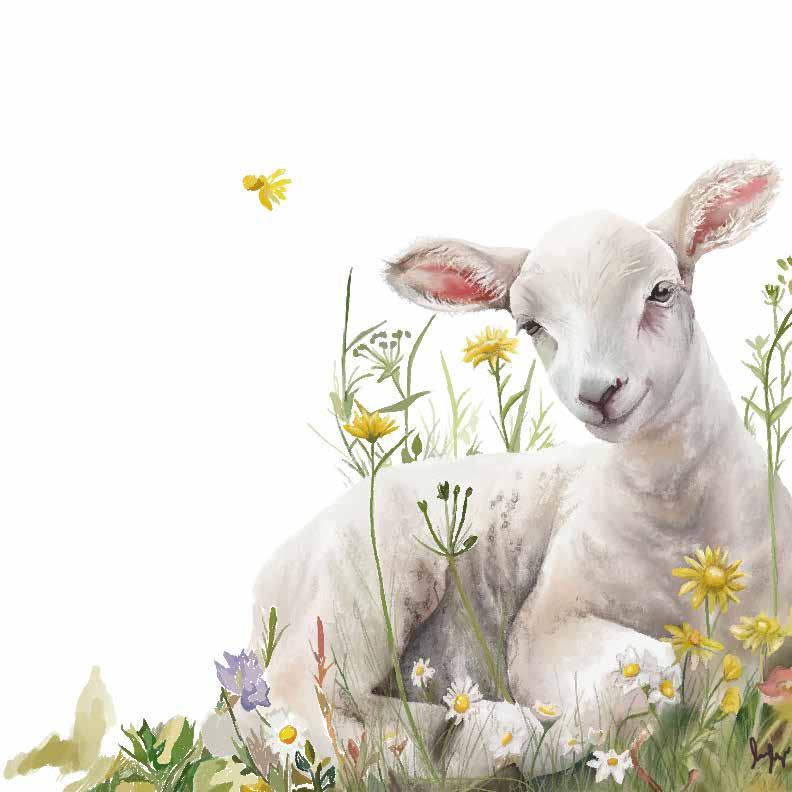
WGFD approves amended elk feedground plan
The public has a wide range of opinions on how – and if – the Wyoming Game and Fish Department (WGFD) should manage its winter elk feedgrounds in Western Wyoming.
They cited healthy big game animals, encroaching chronic wasting disease (CWD), feedground closures and details in the revised Winter Elk Feedground Management Plan.
In the end, the Wyoming Game and Fish Commission meeting in Pinedale earlier this month approved “the plan to make a plan” with a couple of changes.
Elk feedgrounds in Wyoming
Pinedale Region Supervisor John Lund reported on the very healthy Sublette County, Star Valley and Jackson Hole elk herds which are fed every winter for decades, as compared to pronghorn and mule deer which were decimated by disease and starvation early this year.
WGFD uses these 22 state feedgrounds on public and private lands to keep elk from spreading diseases – brucellosis and the growing threat of CWD – and private property damage to rangelands and haystacks.
The concept of feeding elk that could not migrate out of Jackson Hole in winter began in 1909-10, although conservation groups there have since called for feedground closures.
In 1912, federal funds were allocated to the National Elk Refuge, which the U.S. Fish and Wildlife Service still operates in Jackson. In 1929, WGFD became involved in winter feeding and property damages issues.
Earlier in the day, the commission approved the state wildlife agency’s next step of identifying the Sublette Pronghorn
“President Biden butchered this decision,” states Tester. “By cutting corners to resume beef imports from a country with a recent history of FMD, the Biden administration is jeopardizing our food supply and giving consumers and producers a raw deal.”
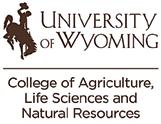
Please see BAN on page 13
Agriculture plays an essential role in Easter
Easter symbolizes rebirth, as the Earth begins to awake from its chilly sleep. Leaves appear on the trees, birds begin to sing and the days are longer and brighter, meaning spring is in full swing and growing season for farmers is ready to start, if it hasn’t already.
Agriculture plays a major role in Easter. For some, the Easter egg is a symbol of birth and the beginning of life, much like what is seen by farmers each year during growing season and ranchers as they welcome new members to their herds.
Americans celebrating Easter will spend about $5.3 billion on food for the holiday, while nine out of 10 people celebrating Easter will purchase candy – a total of nearly $2.2 billion – making it the second best-selling candy holiday in the U.S.
Easter eggs
Many Easter traditions have been around for centuries, although they have evolved over time. One of the most prominent
Energy innovation
UW seminar hosts panel discussion on energy development and ranch management collaboration
The University of Wyoming (UW) College of Agriculture, Life Sciences and Natural Resources (CALSNR) held the second installment of its Ranching in the West Seminar Series on March 18 in Gillette.
The panel discussion focused on energy innovations and collaboration between the energy and agriculture sectors and featured six notable panelists from across the state of Wyoming, including Wyoming State Sen. Eric Barlow, Rock Springs Grazing Association Operations (RSGA) Manager Don Schramm, Landman Jaycie Burch, Peabody Senior Land Manager Fred Eden and Ranchers Frank and Terry Henderson.
Challenges
The panel began by discussing the challenges faced when balancing ranching needs with energy development.
Schramm shared he believes the biggest challenge is understanding mineral ownership, as different entities may own the surface rights, the pore space and the mineral rights on one
China poses danger to American agriculture
The House Agriculture Committee held a full committee hearing on March 20 in Washington, D.C. on the dangers China poses to American agriculture.
In his opening statement, House Agriculture Committee Chairman Glenn “GT” Thompson (R-PA) says, “The People’s Republic of China, governed by the Chinese Communist Party (CCP), has gone out of its way to reduce its reliance on American agriculture, all the while aggressively pursuing tactics threatening our nation’s ability to feed itself.”
He notes over the last few years, China has stolen U.S. intellectual property, hacked critical cybersecurity and related infrastructure, weaponized agricultural
trade and acquired American farmland at an alarming rate, disrupting national security, rural communities and the country’s resiliency.
“As many of you know, in 2021, the U.S. Department of Agriculture (USDA) estimated foreign investments in U.S. agricultural land grew to nearly 40 million acres,” he states.
However, a few months ago, the Government Accountability Office (GAO) released a report showing gaps in the U.S. reporting framework and how improving the recording system could reduce national security risks related to foreign investment.

Here at the Roundup office and across the state at our editors’ desks, we receive a huge amount of agriculture news, which is good. But lately, the news we’ve been getting out of Washington, D.C. is not so good for our industry.
We try to be positive and look for news placing agriculture in a good light and information to help our readers on their operations. We also want to reach non-ag readers and assure them the food our industry provides is the safest and most nutritious in the world.
It is quite the balancing act for us, but one we are proud to deliver.
It is really disheartening to read agency reports from Washington, D.C. every day, telling us of more restrictions being forced on our lives and limiting agriculture production across the nation.
As we have noticed first-hand, the West is taking the hardest hit, as it seems half of the politicians and bureaucrats in Washington, D.C. are experts in managing arid lands, wildlife and livestock from their offices.
We’re being blamed for climate change, pollution and all of the ice they think is disappearing from the planet. Activists are the scientists of today.
I recently read an article titled “What Would Happen If Everyone Suddenly Stopped Eating Meat.”
This MSN article really blasts “beef guzzling” countries like the U.S., as they think cows are the worst polluters on the planet.
Some studies say agriculture is responsible for 11 percent of Earth’s pollution. We wonder why they are pointing their finger at ag while there is 89 percent left to share the blame.
We realize cattle are responsible for approximately two percent of pollution and are working to lower this number, but grazing animals – including elk, bison and other ruminants –help sequester carbon into the ground with proper grazing. Which is good.
But, what would happen if everyone actually stopped eating meat tomorrow?
“It would have huge consequences – a lot of them probably not anticipated,” said Keith Wiebe, senior research fellow at the International Food Policy Research Institute. “Such a quick shift probably wouldn’t cause the sort of turmoil which would come if the planet immediately ditched fossil fuels. But still, the upshot could be tumultuous, upending economies, leaving people jobless and threatening food security in places which don’t have many nutritious alternatives.”
I’ve read where livestock accounts for about 40 percent of agriculture production in rich countries and 20 percent in lowincome countries, and it is vital economically and nutritionally to the lives of 1.3 billion people across the world, according to the United Nations’ (UN) Food and Agriculture Organization.
One-third of the protein and nearly one-fifth of the calories people eat around the world come from animals.
I wonder why the UN is telling us this and then telling everyone to get rid of cattle? If we have to get rid of our cattle, sheep and goats, then India needs to get rid of their water buffalo and Yellowstone National Park needs to get rid of their bison.
I think a lot of those opposed to livestock production and eating meat belong to extreme animal rights groups which raise millions of dollars annually to just fund their top people. Agriculture is just the scapegoat.

Most readers will have heard about the 30x30 program which seeks to have 30 percent of the Earth under a protective designation by 2030, and the Biden administration has signed on, committing to conserving 30 percent of American lands and waters by 2030.
The administration named this U.S. initiative “America the Beautiful.”
But, readers may not have heard of 50by40, “a coalition of organizations dedicated to cutting the global production and consumption of animal products by 50 percent by 2040.”
They’ve declared, “Livestock production is the New Coal.”
The chairman of the board of directors of 50by40 is Charles Laue, a vegan and animal rights philan-
thropist who also serves on the boards of the Humane Society of the U.S. and the Good Food Institute, created to promote plant- and cellbased alternatives to animal products “to effect the transformation of the global food system.”
He’s also founder of Stray Dog Capital, a venture capital fund which invests in companies producing plantbased and alternative protein foods.
The 50by40 collaboration includes organizations “each working to transform the global food system –whether focusing on climate change, health and nutrition, meat reduction and alternatives, sustainable food systems, Just Transition or other strategies to help achieve their collective goal.”
The goal of the project is
to reduce global production of animal products by half by 2040, with “strategies” based on a variety of focus areas, from animal rights to climate change – but all joined together in their single goal.
Anti-ag groups oppose livestock production
It’s the climate change argument to which most of these special interest groups have coalesced, and there are a variety of networks working toward this end.
For example, climate change is now used by antilivestock groups like the Center for Biological Diversity and Western Watersheds Project, “creative confrontation” groups like Greenpeace, wolf advocacy groups like Wolves of the Rockies and National Wolfwatcher Coalition, vegan
and animal rights organizations and businesses and advocacy groups like Footloose Montana, Project Coyote and WildEarth Guardians.
All of these organizations signed a letter to Secretary of Agriculture Thomas Vilsack earlier this year requesting he “immediately make meat and dairy reduction a key part of U.S. Department of Agricultureʼs (USDA) climate strategy” and to align all USDA programs with this new strategy.
The letter suggested “cutting 90 percent of U.S. beef consumption and reducing half of our consumption of other meats with plantbased foods would save more than two billion tons of greenhouse gases (GHG) from being released by 2030 Please see 50BY40 on page 11

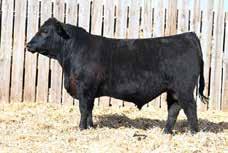
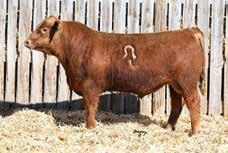


Mystery illness confirmed
A mystery illness which has impacted dairy herds in the Texas Panhandle, New Mexico and Kansas now has a diagnosis – Influenza A. The U.S. Department of Agriculture (USDA) says genetic sequencing revealed it’s the same strain of highly pathogenic avian influenza (HPAI) that’s been in the U.S. for two years.
USDA’s Animal and Plant Health Inspection Service (APHIS) says the National Veterinary Services Laboratories (NVSL) detected Influenza A in samples from several impacted herds in Texas, Kansas and New Mexico.
The virus is carried by wild waterfowl, which experts think is how the illness is spreading. Even with the diagnosis, USDA is still not recommending movement restrictions of animals.
USDA reports affected dairy cows do not appear to be transmitting the virus to other cattle within the same herd, and APHIS says based on findings from Texas, “The detections appear to have been introduced by wild birds. Initial testing by the NVSL has not found changes to the virus that would make it more transmissible to humans, which would indicate the current risk to the public remains low.”
APHIS also says federal and state agencies are moving quickly to conduct additional testing for HPAI, as well as viral genome sequencing to better understand the situation.
Officials are strongly advising dairy producers to use all standard biosecurity measures. They note itʼs important for producers to clean and disinfect all livestock watering devices and isolate drinking water where it might be contaminated by waterfowl.
Producers are also being asked to notify their herd veterinarian if they suspect any cattle within their herd are displaying symptoms of this condition.
The dairy industry sent out a joint release following the news, reminding consumers milk is still safe to drink.
“Importantly, USDA confirmed there is no threat to human health and milk and dairy products remain safe to consume. Pasteurization kills harmful microbes and pathogens in milk, including the influenza virus,” said the National Milk Producers Federation, the International Dairy Foods Association, the U.S. Dairy Export Council and Dairy Management, Inc.
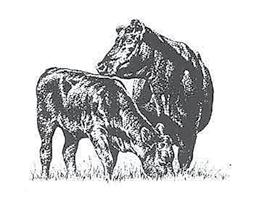

Scholarships available
Continuing to support the next generation of leaders in the beef industry, Certified Angus Beef (CAB) will give a record amount of $100,000 in scholarships across three categories this year. College students with a passion for agriculture and a drive to innovate are encouraged to apply for this scholarship opportunity.
The Colvin Scholarship Fund, named in honor of Louis M. “Mick” Colvin, cofounder and former executive director of CAB, aims to empower students who are dedicated to advancing the beef industry.
Over its two-decade legacy, the fund has supported more than 100 students pursuing their educational and professional goals in agriculture. With increasing support from brand partners, this amount continues to grow. In 2023, CAB awarded $81,500 to 23 scholars.
The 2024 Colvin Scholarship supports the next generation of agricultural leaders who are dedicated to preserving farm and ranch traditions, researching and developing improved beef quality practices and devoting their careers, studies and activities to making the beef industry even better.
The production agriculture, undergraduate and graduate scholarship categories each have unique requirements including essay questions, resumes and letters of recommendation.
Top-place winners in each category will receive $7,500 and an all-expense paid trip to the 2024 CAB Annual Conference in Verona, N.Y., providing them with a platform to connect with professionals from across the beef industry.
Applications for the 2024 Colvin Scholarship are now open and will close April 30.
Interested students can learn more about eligibility criteria and apply by visiting certifiedangusbeef.com/ recruiting/
USDA accepting applications
U.S. Department of Agriculture (USDA) Rural Development Under Secretary Dr. Basil Gooden announced USDA is accepting applications until May 21 for funding under the ReConnect Program.
This is the fifth round of funding under the program, which provides loans and grants to bring high-speed internet to the most remote and difficult-to-serve rural and Tribal communities in America.
A total of $700 million is available under four funding categories – up to $200 million available for loans, up to $200 million available for loan and grant combinations, up to $150 million available for grants and up to $150 million available for grants serving Alaska Native corporations, Tribal governments, colonias, persistent poverty areas and socially vulnerable communities.
Packing plant catches fire
A truck parked in the loading dock at the National Beef Facility in Liberal, Kan. caught fire at 9:50 p.m. of March 20 and spread to other trailers and a portion of the loading dock, according to a statement from the company.
The National Beef statement went on to say the facility was operating at the time of the fire and was evacuated for the safety of employees and others onsite. Emergency services extinguished the fire within a couple hours with no injuries reported.
National Beef said it was grateful for the quick response and support of the Liberal Fire Department, Liberal Police Department and other emergency services.
The plant, which can process 6,000 head per day, is one of the largest beef processing plants in the country. JBS, Cargill, National Beef and Tyson all have plants with a 5,000- to 6,000-head daily capacity. National Beef is owned by Marfig, a Brazilian multinational company.
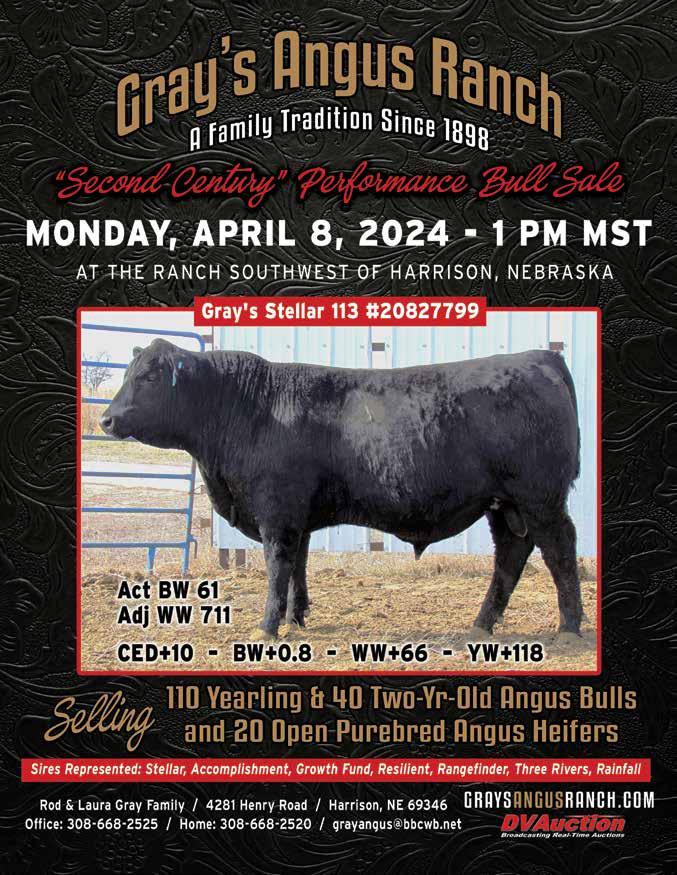
The U.S. Department of Agriculture’s Under Secretary for Trade and Foreign Agricultural Affairs Alexis M. Taylor arrived in Seoul on March 25 to launch an agribusiness trade mission.
Taylor leads a delegation comprised of officials from 48 agribusiness and farm organi-
USDA launches trade mission
zations and five state departments of agriculture seeking to develop strong ties with Korean partners and introduce their diverse products to Korean consumers.
Korea and the U.S. celebrated the 10th anniversary of the U.S.-Korea Free Trade Agreement in 2022. This
agreement supports the bilateral trade relationship which accounted for South Korea ranking as the U.S.’s fifth largest market for agricultural and related products in 2023, with more than $8 billion in exports.
This week, local staff from Foregin Agriculture Service Seoul will host business meet-
ings between U.S. trade mission delegates and Korean companies looking to import American food and farm products. The trade mission itinerary also includes bilateral meetings with Korean industry and government officials and retail promotions featuring U.S. products.
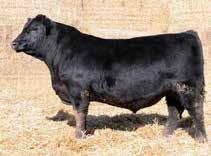
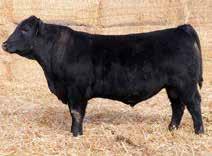

BLM places fire restrictions
In coordination with county partners, the Bureau of Land Management (BLM) Newcastle Field Office is implementing stage one fire restrictions for BLMadministered public lands in Crook, Weston and Niobrara counties. The restrictions took effect on March 22.
“Last summer’s moisture and cool weather brought an abundance of grass and other fine fuels to public lands within the district,” says High Plains District Fire Management Officer Craig Short. “This, in combination with the lack of moisture and warm, windy weather we’re experiencing, has created an environment susceptible to wildfires.”
For more information on BLM fire restrictions or conditions, contact a local BLM office or visit blm.gov/ wyoming-fire-restrictions
Export data released
U.S. pork exports raced to a great start in 2024, according to January data released by the U.S. Department of Agriculture (USDA) and compiled by the U.S. Meat Export Federation (USMEF).
Although January pork exports were led by another powerful performance in leading market Mexico, U.S. pork continued to make gains in a wide range of Western Hemisphere and Asia-Pacific destinations.
With momentum continuing to grow in South Korea, Central and South America, Australia and Malaysia, pork exports totaled 251,424 metric tons (mt) in January, up six percent from a year ago. Export value also increased six percent to $682.1 million.
January beef exports totaled 99,764 mt, down one percent from a year ago. But, export value climbed nine percent to $763.8 million, as value trended higher year-overyear to South Korea, Japan, Mexico, Canada, Central America, the Caribbean and Hong Kong.
Beef variety meat exports increased 12 percent from a year ago to 23,138 mt, while value climbed 16 percent to $89 million, led by growth in Japan, Egypt, Mexico, Korea, Peru and Hong Kong.
January exports of U.S. lamb totaled 303 mt, up 28 percent from a year ago and the largest since March. Export value increased 53 percent to $1.7 million, the highest monthly value since December 2019.
Export growth was led by the Caribbean and Canada, while exports to Mexico also increased year-over-year in value.
A detailed summary of the January export results for U.S. beef, pork and lamb, including market-specific highlights, is available from the USMEF website.
For questions, contact Joe Schuele at 303-547-0030.
SALE REPORTS
Sinclair Cattle Co. Annual Production Sale
Reported By: Curt Cox, WYLR Field Editor March 23, 2024
Buffalo Livestock Auction, Buffalo
Auctioneer: Roger Jacobs
126 Yearling Angus Bulls Avg. $4,812
13 Yearling Registered
Angus Heifers Avg. $3,381
65 Yearling Commercial Replacement
Heifers Avg. $2,250
One Semen Package supporting the Wyoming 4-H Foundation and Wyoming
FFA Foundation $2,250
High Sellers
Bulls
Lot 9 – Sinclair Emula-
tion L537 – Price: $11,500
DOB: 2/11/23 Sire: N Bar
Emulation EXT Dam’s Sire:
Basin Rainmaker 654X
EPDs: BW: +0.5, WW: +43, YW: +81 and Milk: +28
Buyer: CCK Angus Ranch, Florence, S.D.
Lot 66 – Sinclair Black
Iron L504 – Price: $11,500
DOB: 1/31/23 Sire: Sinclair
Black Iron 7UR26 Dam’s


Sire: Basin Rainmaker 654X
EPDs: BW: +4.8, WW: +53, YW: +98 and Milk: +24
Buyer: Brock Boyle, Danbury, Iowa
Lot 24 – Sinclair X-Plus
L101 – Price: $10,500 DOB:
3/9/23 Sire: Sinclair Emulation XXP Dam’s Sire:
Sinclair Rito Legacy 3R9
EPDs: BW: +2.1, WW: +49, YW: +94 and Milk: +23
Buyer: Jake Brackett, Rogerson, Idaho
Lot 1 – Sinclair Longmire L505 – Price: $10,000
DOB: 2/1/23 Sire: Reisig Longmire 8326 Dam’s Sire: Sinclair Exactly 4U2 EPDs: BW: -0.3 WW: +44, YW: +82 and Milk: +22 Buyer: 7 Hanging 7, Grass Range, Mont. Registered heifer
Lot 139 – Sinclair Lady L385 7X14 – Price: $6,000
DOB: 3/13/23 Sire: Sinclair Exquisite 0X2 Dam’s Sire: N Bar Emulation EXT
EPDs: BW: +0.9, WW: +35, YW: +57 and Milk: +21
Buyer: Brookhill Angus, Flemingsburg, Ky.
Migration Corridor undertaking a more detailed “biological risk assessment” of the corridor segments from Rock Springs to Jackson Hole.
“We’ve heard a lot of important discussions today, and we’ve got one more for you,” Lund told the commission, including Chair Richard Ludvig, Mark Jolovich, Ashlee Lundvall, Ralph Brokaw, Ken Roberts and John Masterson.
Lund was joined by Jackson Wildlife Coordinator Cheyenne Stewart and Regional Wildlife Supervisor Brad Hovinga, who gave commissioners a more detailed review at their January meeting.
When WGFD employees began researching the status of fatal CWD to update its management plans, Lund said, “It was very obvious winter elk feedgrounds needed to be included in the plan.”
The question always comes up, “Why do we feed elk?”
“The goal is to reduce private property damages –for which WGFD provides some compensation. But, the absolute priority is to reduce commingling of diseasecarrying elk and cattle during calving season, reduce elk winter kill due to lack of migration and winter forage and reduce competition with other wildlife species on winter ranges,” he said.
Elk survival also provides excellent hunting opportunities.
Phase One of researching and revising the state’s elk feedground management plan began with a group of local biologists, followed by Phase Two in 2021-22 with public and stakeholder engagement.
In 2023, WGFD hosted public meetings, taking significant input of written and online comments. Over the last several months, the team incorporated many comments to come up with its final draft in February, according to Lund.
The final product, posted on the WGFD website, contained many editorial changes and clarifications, removing redundancies and adding summaries, tables and figures.
Cattle production values were added and sideboards and goals clarified. More information about brucellosis and CWD was added all from public input.
A controversial topic Stewart said maintaining elk feedgrounds is complicated and controversial and CWD detection rates are rising across the state and moving toward the feedground system. A feedground captive herd mimics the animal’s natural behavior toward high density. However, the CWD prion is known to be longlasting and unaffected as it passes through an infected animal into the environment.
Elk herds winter on the same ground year after year, Stewart said, and when they migrate off of feedgrounds in the spring, little is known
about how the environment is affected.
“We have never studied CWD in a feedground system,” she said. “Finding out how quickly it spreads, to what prevalence and how other cervids are impacted are very specific things we don’t know yet.”
“Many expectations are assumptions based on modeling which shows CWD prevalence will grow quicker among feedground elk than free-ranging elk,” she added. “To just stop feeding shows an immediate population decline with more elk on winter ranges. We’re not proposing we stop feeding. It’s critical to have management direction.”
The final draft lists more than 100 adaptive strategies, including test and slaughter, for each feedground management action plan (FMAP) for each feedground.
Stewart also requested moving feedground quotas for six elk herd units – three in the Pinedale region and three in the Jackson region – away from the commission’s policy.
Unique herd unit objectives could then be incorporated into each FMAP so an approved plan is adaptable to nuances. Low-density hay feeding and shortened seasons are already in use.
“We will assess strategies at each feedground and implement an appropriate combination of strategies with the public and stakeholders and present the commission with each FMAP for approval,” she noted.
Commissioners said they know they have to start somewhere.
Outfitter comments
Western Wyoming outfitters made short comments and asked about WGFD’s goals.
With seven hunting camps from the Tetons to the Wyoming Range, Outfitter Dustin Childs said he struggled through the final draft and didn’t find the meat and potatoes until page 50.
“We just listened to how the pronghorn and mule deer are doing right now. Elk numbers in Wyoming are as good as ever. These feedgrounds work. They’ve worked for over 100 years,” Child said. “Feedgrounds have persevered and elk have persevered because of the feedgrounds.”
A major concern is the WGFD’s approach to lower elk numbers and moving them to natural winter ranges.
In the Hoback Basin, WGFD operates two elk feedgrounds – the Dell Creek and McNeel feedgrounds. Child also referred to the Horse Creek and Camp Creek feedgrounds in the Hoback Canyon and closer to Jackson.
“I just drove through Bondurant. There’s no forage showing. I read this as a way to not shut feedgrounds down but to reduce the number being fed. My fear is wildlife managers will look at Camp Creek and Horse Creek and say, ‘There are too many elk’ and reduce the quota from 1,200 to 850,” he said.
Child also pointed to auxiliary management –emergency feeding where hunting strategies have been ineffective.
“If a hunting season is not working, are you going to use aerial gunning – a helicopter and a machine gun?” he asked.
WGFD Director Brian Nesvik said, “Auxiliary management is a new term to address where normal hunting seasons are not working.”
This is used exclusively with private lands, where the owner allows 10 hunters to get licenses and hunt elk damaging property or commingling.
Zach Key, a LaBarge manager who was on the feedground plan committee, said he proposed more feedgrounds to spread elk out over the landscape, which was not included in the final draft.
He asked who would be running this operation in 10, 20 or 50 years and sug-
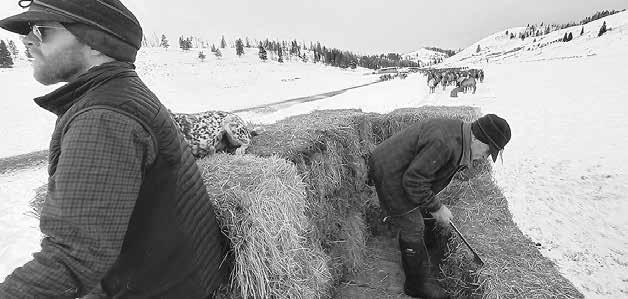
gested WGFD should revisit its own feedground management every five or six years to incorporate new science.
Other speakers suggested wolf predation could help reduce elk numbers without feedgrounds, and the agency should create a data-driven approach.
Meghann Smith of the Sublette County Conservation District (SCCD) Board brought up another detail, asking the Commission to include local government and local stakeholders when
reviewing a FMAP. SCCD
Board Chair Coke Landers explained the county wants a seat at the table. Brokaw agreed.
Hovinga made closing comments, saying the final draft “is a long-term work in progress.”
Nesvik also addressed commissioners about CWD and the effects on tourism, outfitting, hunting and ranching.
“It’s a catastrophic disease for cattle. Doing nothing is not an option,” he said.

Commissioners then crafted a motion to accept the final winter elk feedground management plan with changes to include local government, delete its final sentence, move regional herd unit management quotas to the agency and review the overall plan’s effectiveness every five years.
The motion was approved.
Joy Ufford is a corresponding writer for the Wyoming Livestock Roundup. Send comments to roundup@ wylr.net.
FEEDERS Reverse L 80 Blk (14 Red) Strs, 650#, Weaned a long time, Bunk Broke, Been on a Light Grower Ration, Vac. Program, Wintered for grass
Jim Jankovsky 50 Blk Strs & Hfrs, 650#, Weaned a long time, Bunk Broke, Hay and Corn Ration, Branding Shots: Vira Shield 8, Ultrabac 8, Heifers are Bangs Vac.
WEANED CALVES
Murray Ranch/Debra & Bruce Murray 110 Hereford few Hereford-x Hfrs, 550-650#, Weaned a long time, Been on a Grower Ration, Branding and Pre-cond. Shots: 7-way, Vira Shield 6 w/Somnus, Nasalgen, Knife Cut Falls Ranch 90 Blk Strs, 525-650#, Weaned a long time, Bunk Broke, Light Grower Ration, 3 Rounds of Modified Live Vac. Program, No Implants, Home Raised, Strictly Vermilion Genetics
Greg Gardner Livestock 75 Blk Strs & Hfrs, 550-625#, Weaned a long time, Bunk Broke, Been on a Grower Ration, Complete Vac. Program, Home Raised Lazy A 1, LLC 60 Blk/Bwf Strs, 600-700#, Weaned since November, Running Out on Cornstalks supplemented with Ground Hay and Silage, Bunk Broke, First Round of Shots: Nasalgen 3 PMH, Somnushield, Micro B (1 dose), Vista BVD, Multimin, Poured w/Dectomax, 2nd Round of Shots: Vista 5, Vision 7 w/Somnus, Vit. A& D, Poured with Ivomec, No Implants
Barker Ranch LLC 40 Blk/Char Strs & Hfrs, 400-500#, Weaned since Oct. 10, Running out on Pasture, Bunk Broke, Cake Broke, Been on a Blue Print Mineral Program, 3 Rounds of Modified Live Vac. Program CJG Ranch 25 Hereford Strs, 600-650#, Weaned a long time, Bunk Broke, Been on a Grower Ration, All Shots
Tyson Frank 19 Blk Strs & Hfrs, 600#, Weaned since Nov., Been on a Grower Ration, Complete Vac. Program, SafeGuard Wormer, Clean-up
Neil Hennek 8 Blk Strs & Hfrs, 500-600#, Weaned since Oct. 1, Grass Hay Fed with some Grain, Bunk Broke, Branding Shots: Vision 7 w/Somnus, Pyramid 5, Weaning Shots: Vision 7 w/Somnus, Pyramid 5, Poured with Ivomec, No Implants Cattle Country Video – 1pm MT
Greg Gardner 97 Weaned Hfrs. 100% Black. Base Wt: 650 lbs. Wt Stop: 665 lbs. Slide: .16 cents. Located: Lusk, WY. Delivery: 4/4/24 to 4/9/24. Frame: Med-Large. Flesh: Med. Wt Var: Uneven. Origin: Ranch Raised. Feed: Grower Ration: 26 lbs/hd/day. 10% Alfalfa hay, 10% Cornstalks, 10% Beet Pulp, 10% Cracked Corn, 20% Haylage, 30% Corn Silage, 10% Earlage. Weigh: Early am gather from pen, weigh on ground w/a 3%. Comments: Fancy, one iron, home raised heifers, wintered to go to grass. Pre-sorted on January 3rd. Test weighed on March 27 – 97 hd at 653 lbs. Rep: Ty Thompson 307-340-0770. www.cattlecountryvideo.com
BRED HEIFERS
Harvat Hay and Cattle 20 Blk Hfrs, Bred to Low Birth Weight/Low PAP Tested Lucky 7 Blk Angus Bulls, CF: April, Shots: Vista 5 VL5, 2 Rounds of Guardian
Travis & Shelly Rodewald 20 Blk Angus Hfrs, Bred to Low Birth Weight Hague Blk Angus Bulls, CF: May 1, Pre-breeding Shots: Bovi-Shield Gold FP5VL5, Pour On, 2 Rounds of Scourguard this winter, 1-iron, Home Raised, Summered at High Elevation

UW to host field day
The University of Wyoming’s (UW) annual ram test will conclude with a public field day on April 13 at the Laramie Research and Extension Center.
The event, which begins at 11 a.m., will present results from the 140-day performance test and discuss how test results can be used to make selection decisions.
Lunch, provided by Wyoming Wool Initiative, will be served at noon. Starting at 1 p.m., attendees will have the opportunity to view tested rams and participate in a silent auction.
Ram performance is evaluated based on growth performance, feed conversion efficiency and muscling, as well as wool traits including weight, fineness, length and clean yield. Rams which perform in the top 30 percent of the test are eligible for the Certified Rambouillet Index and Wyoming Certified Index.
This year, a total of 90 rams from 21 ranches in three U.S. states and Canada were entered in the test.
To RSVP for the upcoming field day, e-mail whit. stewart@uwyo.edu or call 307-766-5374 by April 7.
Legislation introduced
U.S. Sens. Mike Rounds (R-SD) and Amy Klobuchar (D-MN) introduced legislation to offer producers fairer market prices for livestock disaster assistance programs.
The Livestock Indemnity Program (LIP) Payment Improvement Act would require the Farm Service Agency (FSA) to make quarterly updates to LIP payment rates which reflect livestock market prices.
The LIP provides payments to eligible livestock owners and contract growers for abnormal livestock deaths caused by an eligible loss condition, such as severe weather, disease or animal attack.
Currently, the FSA is required to update LIP payment rates annually. While the agency occasionally provides periodic price updates, the LIP Payment Improvement Act would make these updates more frequently to reflect an ever-changing market.
“Ranchers often make large financial investments in their livestock and sometimes face heavy losses due to natural disasters and other circumstances beyond their control,” said Klobuchar.
Sixteen million livestock set to perish in Mongolia’s “dzud”
As many as 16 million head of livestock could perish in Mongolia’s “dzud” crisis.
The astonishing figure, equivalent to around one-quarter of the animals herded in the country by the end of last year, is the latest forecast death toll for cattle, goats, horses and other animals which will be lost to the harshest extreme winter weather the country has experienced in nearly half a century.
The forecast was relayed by Member of Parliament Togtokhsuren Dulamdorj, who said on March 20, “A group of MPs listened to information from Deputy Prime Minister Amarsaikhan Sainbuyan about urgent measures needed to solve problems with the mass death of livestock as a result of dzud. There is a preliminary forecast around 16 million animals will die.”
Heart-wrenching loss
Earlier this week, Mongolia’s Emergency Operation Center said the number of lost livestock in the weather disaster had exceeded 4.7 million. The center predicted an impact
Roghair Angus Ranch Ent
Private Treaty Auction will be held April 12, 2024 at the ranch at 1:00 CST Preview the bulls and join us for lunch before the sale.
Selling 3 Three-Year-Old Bulls
14 Two-Year-Old Bulls • 10 Yearling Heifer Bulls
Bulls bred for maternal function and fed to not fall apart while breeding. Yearlings are heifer bulls that are true calving ease specialists. Ohlde, Totton and Beckton Red Angus genetics.

Roghair Angus Ranch Ent
Brad and Shawna Roghair Okaton, SD | 605-669-2328
Brad 605-280-9408
Shawna 605-730-0708
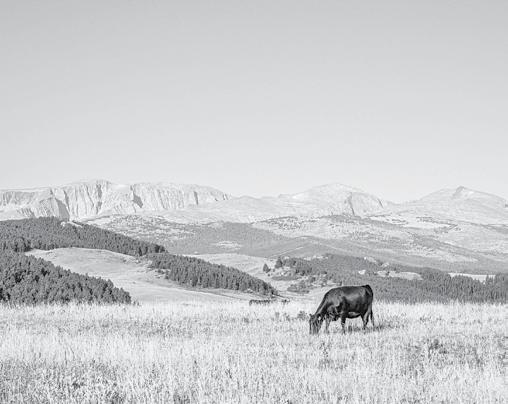
3 miles west of Okaton, SD on old Highway 248 3/4 mile south
greater than the significant 2010 “dzud” event, which resulted in the loss of 10.3 million livestock and affected 28 percent of Mongolia’s population.
On March 20, CBC News Canada reported Olga Dzhumaeva, head of the International Federation of the Red Cross’ East Asia delegation, as saying on a tour of dzud-stricken localities, “We were confronted with heart-wrenching scenes – piles of dead animals scattered across the snowy and icy steppes. Devastation. That’s the word I can use.”
She added, “We see the scale of this crisis worsens. So this is the period where we’ll see the greatest risk of livestock losses, and humanitarian needs continue to escalate. Now they’re coming out of this harsh winter, and the moment they come out of winter, they’ll have to start preparing for the next winter again.”
The extreme weather, with temperatures dropping to negative 30 Celsius – negative 22 degrees Fahrenheit – has covered livestock grazing areas with deep snow and ice and has
impacted around three in four of all herder households, according to officials. The livelihoods of herders who depend on cattle, goats and horses are under severe threat.
Humanitarian response
The International Federation of Red Cross and Red Crescent Societies (IFRC) has launched an appeal for donations.
“As one of the most active humanitarian actors in the country, the Mongolian Red Cross Society (MRCS) is working tirelessly to provide humanitarian assistance to the affected people together with partners in this difficult time. We are grateful the IFRC has always been with us, supporting our humanitarian efforts through the years,” said Bolormaa Nordov, secretary general of the MRCS.
“With this emergency appeal, we hope to minimize the impact of the dzud emergency and support households with longer-term solutions for their lives and livelihoods,” Nordov added.
MRCS is dealing with food scarcity, lack of health-
care access and livelihood destruction in its response to the dzud crisis. Herder families with small children are a particular concern.
The humanitarian response has included the distribution of vital supplies such as warm animal blankets, benefitting 5,100 herder families in urgent need.
“We stand witness to the numerous struggles many herder households face from the loss of their precious livestock to the burdens of financial hardship, limited resources, as well as immense pressures on people’s mental and physical health,” added Dzhumaeva.
“Yet, we see the unwavering hope and resilience of so many families as they battle winter’s wrath with incredible strength. The ongoing livestock deaths, diminishing resources and deteriorating conditions of hundreds of thousands of people in Mongolia this winter is a stark reminder of the urgent need for assistance,” Dzhumaeva concluded.
bne IntelliNews is a business media company which focuses on emerging markets and business news from Eastern Europe, Eurasia, Middle East and Africa. This article was originally published in bne IntelliNews on March 21.
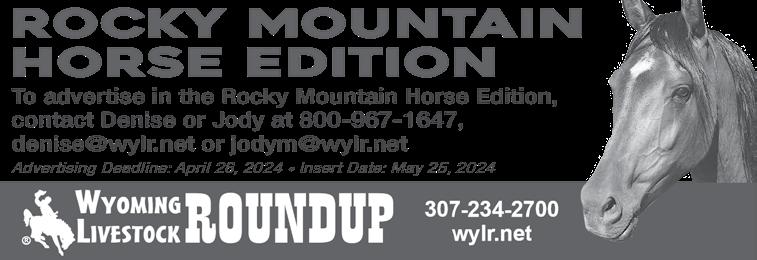

$15,000 IN PRIZES 1/2 SALE PROCEEDS
Could you train a Wild American Mustang in just 120 days?
5 5 5 5 5 5 5 5
APPLY BY 4/1/2024!
www.meekermustangmakeover.org
Questions? Call Trainer Liasion Shanna Lewis, 970-846-9834.
5 5 5 5 5 5 5 5

UNL research identifies the importance of vitamin A for newborn calves
In recent research, the University of Nebraska-Lincoln (UNL) has discovered vitamin A is important to a healthy immune system in newborn calves.
Two studies were conducted to evaluate the correlation between cow and calf vitamin A status and how vitamin A status in cow/calf pairs were influenced by maternal vitamin A supplementation.
In the March 13 edition of the UNL BeefWatch Newsletter, UNL Beef System Specialist and Associate Professor Mary Drewnoski states, “Colostrum is the only way calves can get the vitamin A they need to fight off bacteria that will make them sick.”
six to 14 times greater than that of milk, so colostrum is critical for establishing vitamin A stores in a young calf.
Drewnoski further notes the amount of vitamin A in colostrum depends on the cow’s diet in late pregnancy and how much she has stored in her liver.
Fresh green forage contains high amounts of beta carotene, a vitamin A precursor, and is used by the cow to synthesize vitamin A, UNL research notes.
“Therefore, a sound mineral and vitamin program is vital for the success of any cow/calf operation. We now suggest 75,000 International Units (IU/d) per day, which could come from a mineral mix assuming four ounces per head per day. Producers need to look for a supplement with about 300,000 IU/d per pound,” Drewnoski explains. She adds, “The previous recommendation was 30,000 to 50,000 IU/d.”
meet the calf’s needs so it is of utmost importance for a calf to get adequate colostrum.
“Colostrum replacers and milk replacers do contain vitamin A and can help when colostrum isn’t available. There are also injectable vitamin A options,” Drewnoski says. “These can be used to ‘top-up’ a cow or calf that likely has low vitamin A levels, but they aren’t an effective primary source and aren’t necessary with a good nutrition program.”
access to vitamin A and that it’s always available.
Drewnoski recommends providing one mineral source per 30 head of cattle, noting it is important the mineral doesn’t run out because the most aggressive cows will hog it when it’s available again.
If mineral does run out, she suggests providing loose salt for a day to satisfy cravings before putting out the mineral mix again.
related with effectiveness,” she says. “Mineral supplementation is not magic, and feeding more of a mineral will not necessarily improve performance. Responses will only be observed when correcting a deficiency.”
Thus, the goal, she remarks, is to provide enough mineral to meet cows’ needs without feeding more than needed, thereby adding to cost without providing a benefit.
Mark McConnell 307-438-1218
UNL research identified a cow’s milk is customarily low in vitamin A, and supplementing during lactation will not
Mike McConnell 307-330-5670
However, what is stored in the cow’s liver is not enough to fortify colostrum, meaning vitamin A must come from her diet as well.
In addition to choosing the right mineral supplement, UNL reports it’s important to make sure all cows have
“Developing a free-choice mineral supplement can be tricky with so many options available, but it does not have to be expensive nor is cost cor-
Melissa Anderson is the editor of the Wyoming Livestock Roundup. Send comments on this article to roundup@wylr.net.
Anjie McConnell 307-330-4670
However, it has been revealed not all colostrum contains enough vitamin A, and UNL research concluded what once was “enough” is truly not adequate.
Diane Frank
Cows fed diets primarily consisting of stored forage and concentrates are at risk for vitamin A deficiency because these feeds contain low amounts of beta carotene.
Importance of vitamin A
Vitamin A is needed for calves to have healthy skin and eyes, digestive tracts and respiratory systems.
“Calves are born deficient in vitamin A and depend on colostrum from the mom to provide what they need,” Drewnoski says. “Calves which don’t get enough vitamin A from colostrum are prone to scours and respiratory disease.”
The research notes vitamin A concentrations in colostrum have been reported to be
The only option to ensure pregnant cows are receiving a sufficient amount of vitamin A is through supplementation, according to the research at UNL.
“A cow needs more vitamin A in her diet than previously recommended to provide enough to her newborn calf,” she adds.
Supplementation
UNL research concludes a cow with adequate vitamin A liver stores at the time of calving does not ensure the calf will have adequate vitamin A liver stores.
Bawl of the Calf
By Kristen Ham, Ranch Chic CorralIn the still of dawn’s first light, a single bawl cuts through the night. A testament to the cycle spun, of hard work done under the sun.
From long days in fields of hay, to the careful choice of DNA. Every decision, every care, leads to this moment, raw and bare.
The health of momma, watched with eyes keen, of pastures rich, in shades of
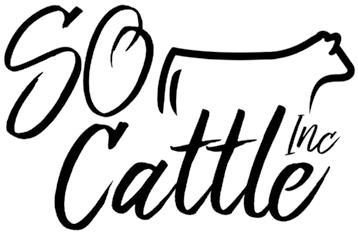

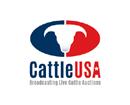
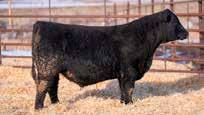
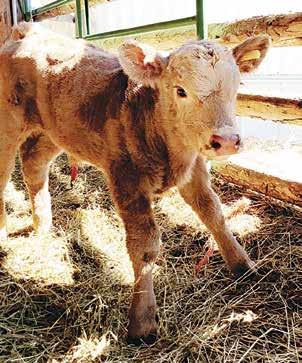
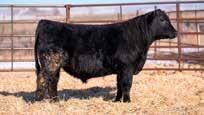
S elling 21 Yearling Bulls
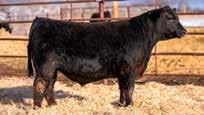
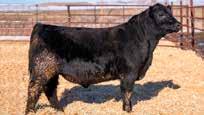
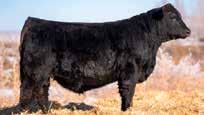
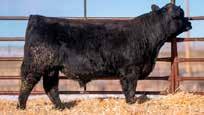
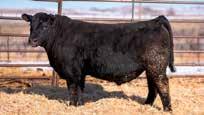

CONNECTING AG to CLIMATE
 By Windy Kelley, Northern Plains Regional Climate Hub
By Windy Kelley, Northern Plains Regional Climate Hub


Recent and Current Conditions
Wyoming experienced its 12th warmest and 16th wettest
February out of 130 years, according to the National Oceanic Atmospheric Administration’s (NOAA) National Centers for Environmental Information database, retrieved March 26.
Scaling to the county level, the adjacent tables include temperature and precipitation rankings of select counties for the month of February.
The U.S. Drought Monitor (USDM) map for Wyo-
ming, released March 21, classifies over 28.5 percent of Wyoming as being abnormally dry (D0), and it shows over 25.5 percent of the state in moderate (D1) or severe drought (D2).
The remainder of the state – nearly 46 percent – is classified as none. In other words, these areas are not experiencing abnormally dry or drought conditions.
View the current USDM map at bit.ly/usdm-wy. Consider submitting a Condition Monitoring Observer Report
at bit.ly/condtionreports
Eight- to 14-day and one-month forecasts
NOAA’s eight- to 14-day forecast for April 3-9, issued March 26, shows a 33 to 40 percent probability of below normal temperatures for all of Wyoming.
For the same timeframe, there is a 33 to 50 percent probability for above average precipitation for the state –with a slightly higher chance in the greater, southwestern corner.
The one-month forecast for April, issued March 21, indicates a 33 to 60 percent probability for above normal temperatures for most of Wyoming. The exception is the greater southeastern corner of the state, where there is an equal chance for below, near or above normal temperatures.
For the same timeframe, the forecast shows an equal

chance for below, near or above normal precipitation for most of Wyoming. The exception is much of the eastern border, where there is a 33 to 40 percent probability for above average precipitation.
For additional information and NOAA forecasts, visit cpc.ncep.noaa.gov
Windy K. Kelley is the regional Extension program coordinator and state specialist for the U.S. Department of Agriculture’s Northern Plains Climate Hub,
the University of Wyoming Extension and WAFERx. She can be reached at wkelley1@ uwyo.edu or 307-367-4380.
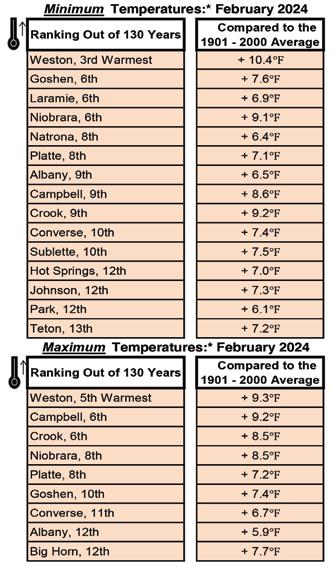
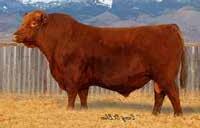
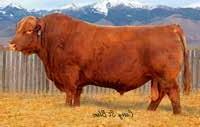
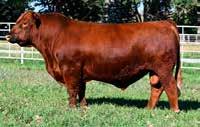
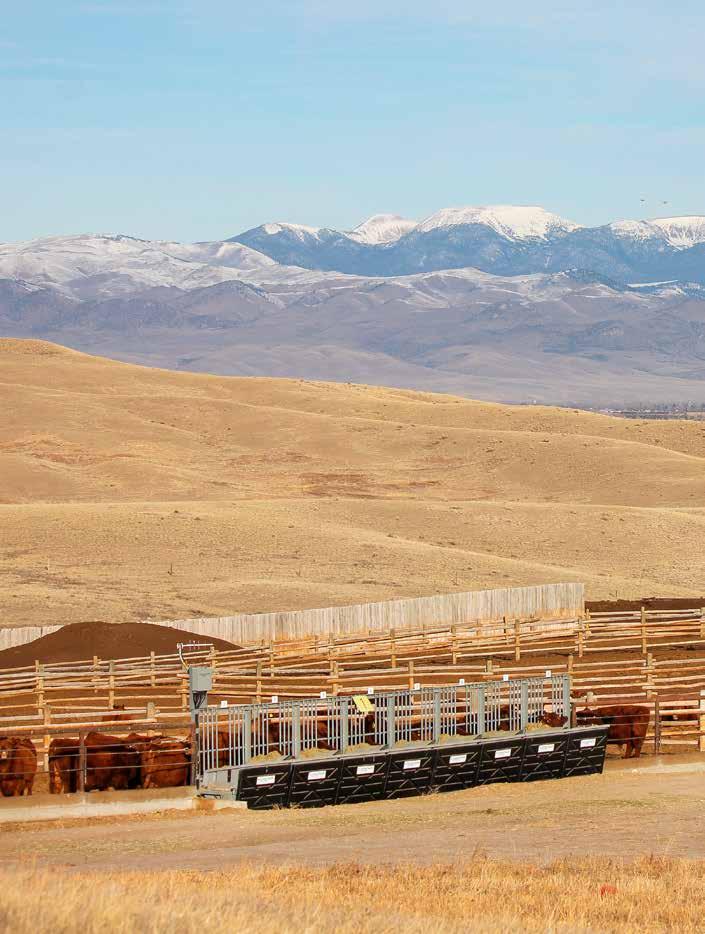

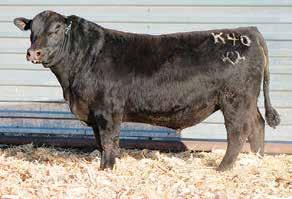


until 5:30 p.m.

I must look like I need some advice because I’ve been getting a lot of it lately. This cattle business is getting harder and harder to figure out. I can’t decide if I should be buying or selling.
I read all of the livestock newspapers, and they said prices were going up. Then I had my palm read, and the palmist said, “Don’t believe anything you read.”
The tax man said I shouldn’t sell because I haven’t owned cattle long
by Lee Pittsenough for long-term profit. But, the futures market made sure there wasn’t any profit.
I sought advice from my accountant, and he said to buy a better computer and to use Quickbooks. I paid $2,000 for a computer, and it advised me, “A fool and his money are soon parted.”
I called up a stockbroker, you know, the one who talks and everybody listens? I listened all right. He left me on hold from 8:30 a.m.
The weather man said, “Dry weather ahead.” We got three wet inches of “partly cloudy.”
The optimist said, “Cheer up, things could be worse.”
And the pessimist said, “They soon will be.”
The banker suggested I sell. After much deliberation, I decided the smart move would be to sell, so I did. Immediately after the auctioneer said “SOLD!” on my cattle, the market immediately jumped five bucks.
The psychiatrist said, “There are two things you should never do alone –make love and sell cattle.”
So, my wife went with me to the auction for moral support and so I wouldn’t do anything foolish – like buy more cattle.
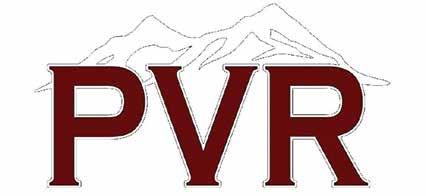
My wife suggested we sit way back in the shadows so no one would notice she was the only female in the place.
Halfway through the proceedings, the auctioneer made the comment, “It sure looks like a good time to buy some cattle. You can’t play the game if you aren’t holding some cards.”
Then my trucker came up and suggested he needed a backhaul, so I figured I might as well buy something.
Two friends, John and Jack, came up and sat right behind us. Every time I would start to bid, one of them would comment, “Those steers are too full,” or “Those steers are not very green.”
The wife sitting next to me had her adding machine
working, and she would chime in, “Too high.”
It seemed every drive of cattle had something wrong with it.
I was getting frustrated and realized this was why most ranchers don’t go to the auction market to see their cattle sell. Then at last, a load came in everybody agreed was just right.
“They sure are green,” said Jack.
“They sure are empty,” said John.
“They sure are cheap,” said my wife.
I bid one time, and the auctioneer hammered his gavel down. My trucker had himself a backhaul.
Then my wife advised me, “You idiot. You just bought back the cattle we sent over here to sell.”
My mouth dropped open as I realized the possibility existed she might be right. I tried to look nonchalant.
“Yes, but they were green, empty and such a good buy. I couldn’t pass them up,” I said.
I ended up taking a tongue lashing from the wife all the way home and got the silent treatment for a week afterwards. As my wonder horse Gentleman and I were admiring our newlypurchased, vaguely familiar set of calves, the long-languishing cowboy poet in me screamed for all the world to hear...
The moral of this story is plain to see.
Take this advice from me:
Don’t take any, even if it’s free.

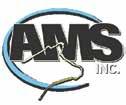
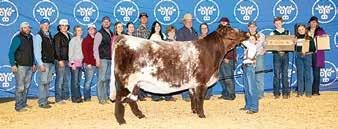
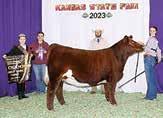
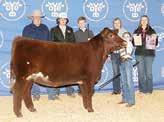
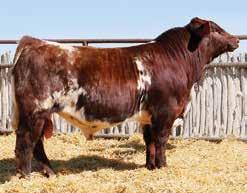
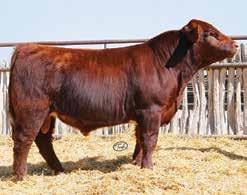

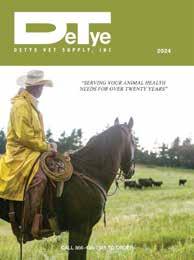
EASTER continued from page 1
symbols of the holiday is the Easter egg.
The egg, an ancient symbol of new life, has been associated with pagan festivals celebrating spring, and from a Christian perspective, Easter eggs are said to represent Jesus’ emergence from the tomb and resurrection.
According to English Heritage, early Christians in Mesopotamia started dying eggs in the period after Easter, and decorating eggs is believed to date back to at least the 13th century.
The practice was adopted by Orthodox Churches, and from there, it spread into Western Europe.
However, this year, egg prices are at near-historic highs in many parts of the world as Easter approaches, reflecting a market scrambled by disease, high demand and growing costs for farmers, notes Texas A&M University AgriLife Extension.
This is the second year
in a row consumers have faced sticker shock ahead of Easter and Passover, both occasions in which eggs play prominent roles.
According to the U.S. Bureau of Labor, in February the Consumer Price Index for eggs increased 5.8 percent, which was 17 percent below the level of 2023, with an average price of three dollars per dozen. This price was 47 cents per dozen higher than in January.
David Anderson, Texas A&M University AgriLife Extension economist at Bryan-College Station in Texas, states in a March 19 article, “Egg prices peaked in February at $3.29 per dozen according to U.S. Department of Agriculture (USDA) Agriculture Marketing Service retail grocery store data.”
Last year around the Easter holiday, USDA reported retail eggs nationally were $2.74 per dozen,
and Anderson says consumers can expect them to be around $2.99 per dozen this year.
According to American Egg Board President Emily Metz, “Government regulations play a part in lifting egg prices. Multiple states, including California and Massachusetts, have passed cage bans for egg-laying hens, and this year bans are set to take effect in Washington, Oregon and Michigan.”
She adds, “Converting to cage-free facilities is a big investment for farmers, and consumers may not always realize it’s a factor in the higher prices they see at the grocery store.”
However, it is estimated about 180 million eggs will be purchased this year in the U.S. for Easter.
Easter meals
When preparing a traditional Easter dinner, no table spread is complete without some kind of protein.
Roasts, glazed hams and lamb have graced tables for years and have established
themselves as foods associated with Easter.
Lamb is the oldest protein dish associated with Easter and stems back to pre-Christian time to the first Passover.
USDA reports, as the Easter holiday approaches lamb cuts on offer were sharply higher and lamb features showed a sharp increase in rack, bone-in leg, boneless leg and semiboneless leg.
Ham has become a popular American Easter dish, a tradition that began in Germany in the sixth century, as cured hams were ready to eat by the time spring rolled around.
According to the National Pork Board, consumers bought 8.5 million pounds of whole hams in the two weeks leading up to Easter in 2023, spending $20.6 million.
Although ham maintains its top spot on the Easter menu with 51 percent of those preparing dinners planning to serve it up
“Egg prices peaked in February at $3.29 per dozen according to U.S. Department of Agriculture (USDA) Agriculture Marketing Service retail grocery store data.” – David Anderson, Texas A&M University AgriLife Extension
this year, the percentage has fallen 10 points since 2022.
Easter candy
According to the National Research Federation, Easter spending for this year is expected to reach $22.4 billion – most of which is spent on candy.
The National Confectioners Association (NCA) reports confectionery sales for the Easter season will surpass $5 billion and nearly two-thirds of Americans will be purchasing candy for Easter.
Over 90 million chocolate Easter bunnies are produced each year, with 60 million consumed in the U.S. alone, according to a Civic Science poll.
Polling data also shows Reese’s continues its reign as the top chocolate brand this year – 46 percent of U.S. adults say they have purchased a Reese’s product in the last month.
But, Hershey’s comes in a close second with M&M’s trailing in third. It’s not sur-
prising Reese’s Peanut Butter Eggs take the top spot for favorite classic Easter candy, while Cadbury Creme Eggs and Chocolate Easter Bunnies are tied for second.
One of the biggest debates of the season is how to eat a chocolate Easter bunny, NCA reports.
Americans are divided – 78 percent start with the bunny’s ears, 16 percent jump in to eat the feet first and six percent of people go right for the tail.
For those who prefer their chocolate egg-shaped, 42 percent of people want a solid chocolate egg, 35 percent of consumers are looking for a filling on their first bite and 23 percent of Americans are happiest with a hollow treat.
The NCA projects U.S. confectionery sales will zoom to $61 billion by 2028.
Melissa Anderson is the editor of the Wyoming Livestock Roundup. Send comments on this article to roundup@wylr.net.
What’s Cooking, Good Looking?
Spring has sprung…technically. In spite of the snow, I’m still embracing all of the springtime flavors!
These Lemon Blueberry Sourdough Discard Scones are the perfect start for Easter morning to tide your family over until dinner.
Lemon Blueberry Sourdough Discard Scones
Ingredients
2 c. flour
1/2 c. sugar
1/4 tsp. salt
3 tbsp. lemon zest
1/2 tbsp. baking powder
1/2 c. blueberries
3/4 c. sourdough discard
1/2 c. butter
1/4 c. milk
1 egg
Icing
1 c. powdered sugar
1-1/2 tbsp. lemon juice
Directions
Preheat the oven to 425 degrees Fahrenheit.
In a large mixing bowl, whisk the flour, sugar, salt, baking powder and lemon zest. With a pastry blender or your fingers, blend in the butter until the mixture takes on a pebbly consistency, it doesn’t have to be perfect.
Add the blueberries.
Mix the eggs, starter and milk together until combined. Pour the wet ingredients over the dry and gently fold the ingredients together with a spatula until all contents stick together. If your dough is a little dry, add additional milk, one tablespoon at a time.
Place the dough on a lightly-floured surface and pat it into a circle about eight inches in diameter. Cut the dough into eight pieces. Place on a baking sheet lined with parchment paper or silicone mat and place in the refrigerator for 30 minutes.
Bake for 20 to 25 minute until the tops are a nice golden color. Cool on a cooling rack.
Mix the lemon juice with the powdered sugar until the icing is smooth. You can add more sugar or juice to achieve the desired consistency. Drizzle over the cooled scones.
Tressa Lawrence lives and works on her family’s cattle ranch, where she runs cattle, cooks a few meals and juggles freelance writing and photography. Comments can be sent to lawrenceranchbeefco@gmail.com.
– equivalent to taking nearly one-half of the world’s cars off the road for a year.”
The letter did not acknowledge the variety of ways U.S. animal agriculture is working to reduce its GHG emissions or that animal ag is a small portion of such emissions in this country.
Individuals signing the letter included British Opinion Columnist George Monbiot, trophic cascades Researcher William Ripple of Oregon State University and others who identified themselves as scientists, including Matthew Hayek and Jennifer Jacquet.
Other than Greenpeace, Hayek and Jacquet are probably the two most favored sources by major media outlets in criticizing animal agriculture while also promoting alternative proteins.
They were colleagues at New York University before Jacquet moved over to the Brown University’s Climate Social Sciences Network.
Both institutions receive funding from animal rights and vegan philanthropists.
Jacquet has been quoted saying, “We need the animal agriculture equivalent of ‘keep it in the ground’ for fossil fuels.”
Global banks commit to net-zero GHG emissions
Another strategy against animal ag appears to be occurring in banking. The United Nations (UN) convened Net Zero Banking Alliance (NZBA) is a group of leading global banks committing “to tran-
sition the real economy to net-zero GHG emissions by 2050.”
U.S. banks joining this alliance include Bank of America, Citi, JP Morgan Chase, Morgan Stanley, Goldman Sachs, Wells Fargo, Areti Bank and Amalgamated Bank.
Concerned with NZBA’s potential impact to American agriculture, a group of 12 state agriculture commissioners joined together in sending a letter to the banks expressing their concern NZBA’s policy could harm food production and result in increased prices, decreased food availability and limited credit access for farmers.
This caught the attention of a group of Congressional members who sent a similar letter to the NZBA banks, pointing out, “The policies the UN has pursued and supported to achieve net-zero GHG emissions in agriculture have incited record-high food inflation, significant reductions in agricultural production and an increased need in humanitarian assistance.”
“At a time when global demand for food is rising and wars continue to affect the global supply of food and agriculture inputs, we cannot sacrifice our nation’s food security to the demands of the far-left climate agenda,” they continue.
Animal rights activists have also recognized both the climate movement and alternative protein markets present “an important opportunity for the animal protection movement” to advance the potential to “eventually
make animal-free consumption a social norm.”
People who question the scientific methodology used in attempt to cause broad societal change are
Top Sellers
Lot 55 – Carter Stel-
lar 6K – Price: $17,500
DOB: 1/8/23 Sire: Sitz
Stellar 726D Dam’s Sire:
Carter Wind Star 218
EPDs: BW: -1.3, WW: +68, YW: +131 and Milk:
+24 Buyer: Little Eight Mile Ranch, Leadore, Idaho
Lot 5 – Carter Stellar 201 – Price: $16,500
DOB: 8/21/22 Sire: Sitz
Stellar 726D Dam’s Sire: Musgrave 316 Exclusive
EPDs: BW: -1.5, WW: +68, YW: +118 and Milk: +16 Buyer: Crow Valley Ranch, Carpenter
Lot 28 – Carter
Extraordinary 239 – Price: $16,500 DOB: 9/28/22
Sire: Carter Extraordinary 100H Dam’s Sire:
Carter Chaps 64F EPDs: BW: +0.6, WW: +77, YW: +128 and Milk: +33 Buyer: 333 Ranch, Elko, Nev.
Lot 15 – Carter Anthem 213 – Price: $12,000 DOB: 8/25/22
Sire: S A V Anthem 0042
Dam’s Sire: Sitz Response 405C EPDs: BW: +1.8, WW: +68, YW: +118 and Milk: +24 Buyer: Steven Johnson, Leadore, Idaho
Lot 48 – Carter
Accomplishment 11K – Price: $11,000 DOB: 1/11/23 Sire: Sitz Accomplishment 720F Dam’s
accused by climate change activists and academics as climate change deniers or “obstructionists.”
But it’s important to know all who are promot-
ing a climate crisis aren’t exactly honest brokers.
Cat Urbigkit is an author and rancher who lives on the range in Sublette County. Her column,

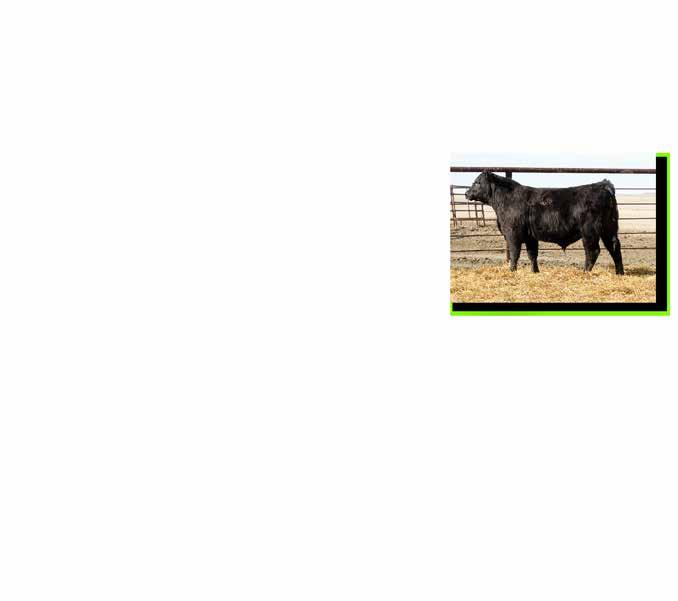


He notes Congress recently took the first steps to address the pressing issue by passing the Consolidated Appropriations Act, focusing on foreign ownership of land by improving the tracking system.
Thompson adds, “China imports almost as much food as the U.S. exports to the whole world, which makes this conversation more difficult. In recent years, the U.S. has seen record export values to China for soybeans, corn, beef, chicken meat, tree nuts and sorghum, all of which are major contributors to our domestic farm economy, underscoring the importance of expanded market access and market diversity elsewhere.”
“So, how do we strike the balance of protecting our producers and consumers and every piece of the agricultural value chain, while keeping pace with China’s needs?” he asks.
China’s influence
South Dakota Gov.
Kristi Noem, a former committee member, was one of the key witnesses testifying before the House Agriculture Committee.
“Over the years, I have witnessed Chinaʼs work to take over America’s vital food supply chain systematically,” she states. “China is buying up our entire food supply chain, and when America can’t feed itself and relies on another country to feed us, it becomes a national security issue. The country that feeds us controls us.”
Noem adds, “For decades we have watched China purchase American fertilizer companies and take ownership of chemical companies.”
“All of this makes us more dependent on China for crop care products, while the U.S. government offers citizenship to members of the CCP in exchange for investment and ownership of our food processing systems,” she points out. “Now, they’re
buying up our land.”
Between 2010-20, the CCP holdings of U.S. agricultural land increased by 5,300 percent, according to Noem.
“Reports show China owns about 384,000 acres of U.S. ag land valued at about $2 billion,” she says. “USDA admits this may not even account for all of the land that has been purchased because the federal government does not monitor and track foreign interests in these large transactions.”
She concludes by noting there is little reporting and very few consequences for allowing countries which dislike the U.S. to buy up the nation’s assets.
During the hearing, U.S. Rep. Mike Gallagher (R-WI) went onto say the U.S. GAO recently reported the USDA is incapable of properly tracking agricultural land purchases by foreign adversaries.
“In a January 2024 report, GAO found USDA published errors in the reporting of Peopleʼs Repub-
lic of China agricultural land holdings and discovered they did not effectively share data with the national security apparatus on land purchases in an effective manner,” he says. “We have little understanding of who really owns our land and who is operating in the U.S., yet the CCP’s new policies advocate for increased foreign land ownership.”
Gallagher concludes, “Our national security is jeopardized daily by our inability to respond to a very blatant threat – the CCP’s acquisition of U.S. farmland.”
Threats
Former Ambassador to the United Nations Agencies for Food and Agriculture Kip Tom, an Indiana farmer, presents his perspective of China’s threat to the American food and agriculture systems to the committee.
“Americans need to understand our national security is dependent upon our food security – Americans cannot take our food systems for granted,” he testifies.
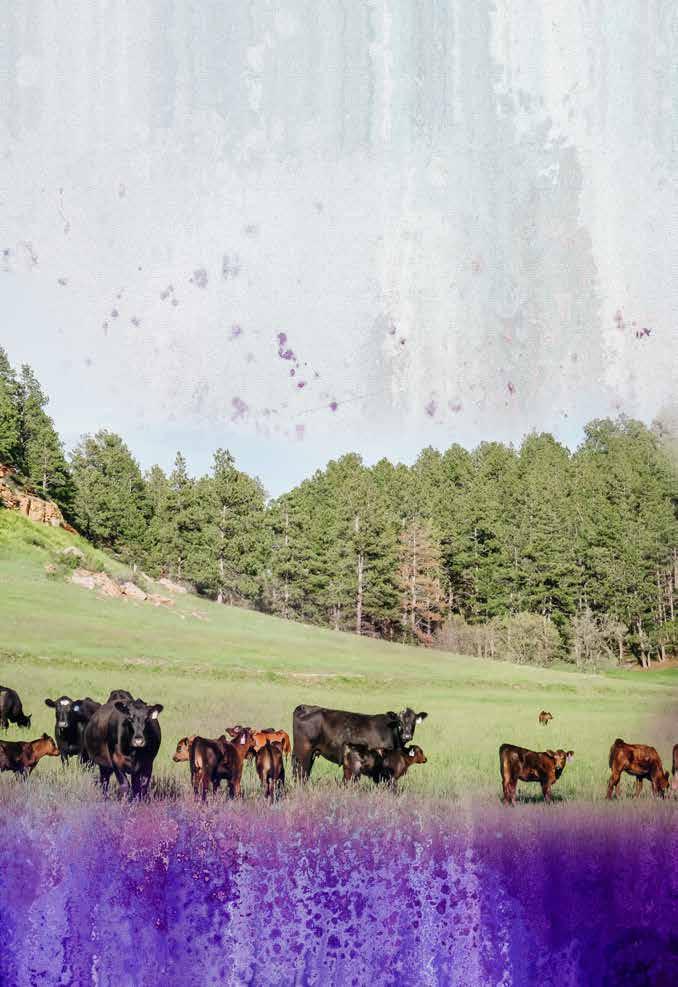
He adds, through experiencing multiple famines, Xi Jinping and the CCP have recognized the importance of food in relation to their position of power in the world and are strategically growing their agriculture production domestically and globally at the expense of the U.S.
Tom highlights a few threats China poses, including cybersecurity and intellectual property theft.
“Data-driven attacks place the U.S. at extreme risk, which could alter or disrupt our systems, lead to incorrect farming decisions and likely harm yields,” he adds. “Critical infrastructure from the electrical grid to supply chain logistics and broadband could be targeted, disrupting food supply chains.”
Tom says the U.S. government is aware of these threats but needs to strengthen the protection of the U.S. food supply, including identifying vulnerabilities and improving the protective measures of government and private entities against cyber threats.
“Portions of our supply chain have been offshored, including several critical building blocks for our food systems such as crop protection products and crop nutrients,” he says.

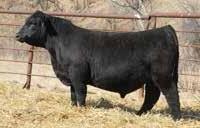
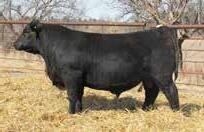
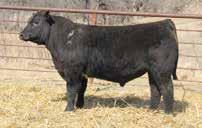

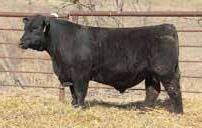
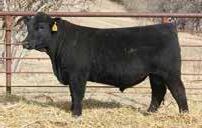
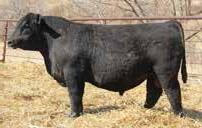
A recent USDA Supply Chain Report shows 70 percent of crop protection products are produced by the Chinese.
“Imagine if they shut off our supply. The economic impact of not using crop protection products in the U.S.
would be significant. Without crop protection products, crop yields would decrease, requiring more land to maintain current production levels,” Tom stresses. “This would lead to higher consumer prices, food insecurity in the U.S. and around the world and a national security threat to the U.S. and our allies.”
Ag leader testifies American Soybean Association President Josh Gackle, a third-generation soybean farmer from North Dakota, notes China accounts for nearly $19 billion of the total $32 billion of American soybeans exported last year.
According to Gackle, the trade war between the U.S. and China in 2017-18 cost the U.S. agriculture industry approximately $27 billion.
“As the U.S. considers actions to protect our national security interests, we must also maintain and protect our economic and trade interests,” Gackle concludes. “Soybean growers need predictability and certainty we will retain market access in China.”
China bought $29 billion in U.S. agricultural goods in 2023 after buying a record $38.1 billion in 2022.
Sales to China continue to fall, and in January, sales to China were $3.1 billion, down 31 percent from a year earlier.
Melissa Anderson is the editor of the Wyoming Livestock Roundup. Send comments on this article to roundup@wylr.net.
Lisco and M Diamond Angus
32nd Annual Bull Sale
Reported By: Curt Cox, WYLR Field Editor March 22, 2024
M Diamond Angus Ranch, Glenrock
Auctioneer: Lex Madden
87 Yearling Angus Bulls Avg. $6,376
12 Summer Yearling Angus Bulls Avg. $9,000
Three Two-Year-Old Angus Bulls Avg. $8,750
Sire: Lisco Grand Finale 4103 Dam’s Sire: LD Capitalist 316 EPDs: BW: +1, WW: +78, YW: +132 and Milk: +27 Buyer: DeGering Livestock, Lusk
Lot 23 – Lisco Growth Fund 3002 – Price: $11,500 DOB: 3/1/23
Sire: Deer Valley Growth Fund Dam’s Sire: S Summit 4604 EPDs: BW: +3.4, WW: +89, YW: +157 and Milk: +31 Buyer: Joe Netz, Lost Springs
Lot 28 – M Diamond Upload 1283 – Price: $11,500 DOB: 3/19/23

2/18/23
Sire: Lisco Grand Finale
4103 Dam’s Sire: M Diamond Businessman 727
EPDs: BW: -0.1, WW: +94, YW: +155 and Milk: +28 Buyer: Bridle Bit
Ranch, Wright
Lot 13 – M Diamond
Grand Finale 2012 – Price: $11,500 DOB: 6/10/22
Sire: Ellingson Upload 1004 Dam’s Sire: S Cornerstone 607 EPDs: BW: +0.4, WW: +73, YW: +119 and Milk: +23 Buyer: Scott Ranches, Douglas
Lot 23 – Lisco Growth Fund 384 – Price: $11,500
DOB: 3/1/23 Sire: Deer Valley Growth Fund Dam’s
Sire: Redland Emblazon
2134 EPDs: BW: +2.2, WW: +70, YW: +126 and Milk: +28 Buyer: Falkenburg Ranch, Douglas
BAN continued from page 1
“We cannot allow beef imports from Paraguay until we have data which shows they are meeting the same high animal health standards as American ranchers, and I’m proud to have secured overwhelming bipartisan support in the Senate to force the Biden administration to reverse course,” he adds.
The resolution will now move to the House for consideration.
Raising concerns
Tester and Rounds’ CRA was created in response to a rule finalized by the U.S. Department of Agriculture (USDA) Animal and Plant Health Inspection Service (APHIS) in November 2023, which would allow the U.S. to import fresh beef from Paraguay.
After conducting a risk analysis, APHIS determined fresh beef could be “imported safely from Paraguay under certain conditions.”
According to APHIS, these conditions require “FMD has not been diagnosed in the exporting region in the past 12 months, the meat comes from premises where FMD has not been present during the lifetime of any of the animals and the animals were inspected before
and after death.” APHIS’s rule raised concern among those in the ag industry, many of which argued the agency’s analysis was based on flawed data, and Paraguay’s inspection processes are not up to U.S. standards.
In fact, in a National Cattlemen’s Beef Association (NCBA) Beltway Beef podcast, released in December – a month after APHIS released the rule –NCBA Director of Government Affairs Kent Bacus states, “One of our key concerns is the fact when APHIS visited sites in Paraguay in 2008 and 2014, they did not have proper protocols in place to gather information accurately.”
“We can’t make a risk assessment off of old data that could potentially be flawed,” he adds.
Jaclyn Wilson, chair of NCBA’s International Trade Committee and a Nebraska rancher, joined Bacus on the podcast, stating, “The main message is we don’t believe the information used to arrive at this decision is 100 percent accurate. We think it deserves review, and we want USDA to take the prudent steps to be cautious before we open up access to a coun -
try which may not be up to our standards.” Industry support
NCBA is one of many agricultural organizations who have offered Tester and Rounds their support.
Other groups endorsing the resolution include the U.S. Cattlemen’s Association (USCA), R-CALF USA, the Livestock Marketing Association (LMA), the National Farmers Union (NFU) and multiple state-level organizations.
“USDA’s decision to allow Paraguayan beef imports into the U.S. creates an unnecessary risk to the health and safety of the U.S. cattle herd,” says Bacus. “U.S. cattle producers are held to the highest food safety and animal health standards in the world, and any trade partner must be able to demonstrate they can meet those same standards.”
“Given Paraguay’s long history of FMD disease outbreaks, it is simply too risky to allow Paraguayan imports without recent site visits to confirm Paraguay’s safety claims,” he continues. “U.S. cattle producers are thankful for the leadership of Sens. Tester and Rounds for applying the CRA to hold USDA accountable and protect our nation’s cattle herd.”
USCA President Justin Tupper agrees animal health and safety is par-
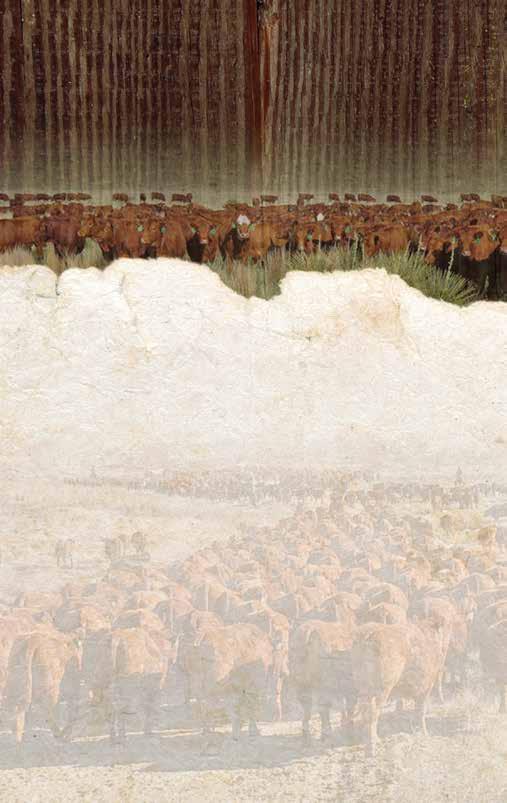
amount and believes the USDA’s risk analysis, which occurred almost a decade ago, is outdated.
He says, “Further, in its regulatory impact analysis, USDA fully admits there is a real possibility we could import beef from an animal infected by FMD. An outbreak of FMD in the U.S. would be devastating for both producers and consumers, causing lasting financial losses between $33 and $93 billion.”
“Importing beef from Paraguay risks undermining consumer trust in the safety and quality of

domestic beef,” comments NFU President Rob Larew. “Given the unresolved concerns about Paraguay’s quality standards and regulatory system, Sens. Tester and Rounds’ leadership in pushing to reinstate the ban is crucial.”
LMA President Mark Barnett also applauds the senators for “standing up for the health of the U.S. cattle industry.”
“The irresponsible decision to allow fresh Paraguay beef imports based on outdated site visits and inadequate data is an unacceptable risk for hardwork-
ing beef producers in this country,” he states.
R-CALF Chief Executive Officer Bill Bullard remarks, “We applaud Sens. Tester and Rounds for protecting the integrity of America’s beef supply. The USDA’s reliance on outdated inspections of Paraguayan food safety protocols is unacceptable. We urge swift passage of this critical measure.”
Hannah Bugas is the managing editor of the Wyoming Livestock Roundup. Send comments on this article to roundup@wylr.net.

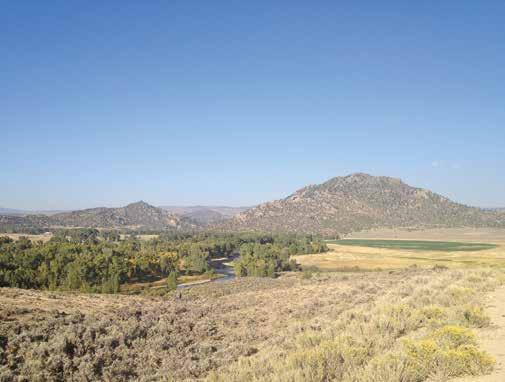



Colorado State University, Department of Animal Science Phone
Lindsey Wamsley 307-710-2938 or Mark Enns 970-491-2722

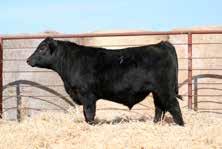
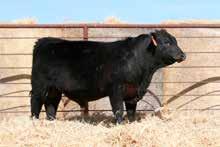
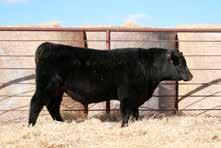
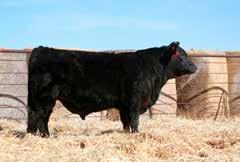
SALES
EVENTS
April 1 Ranching in the West Seminar Series: Leading the Field, Northwest College, Powell. For more information and to register, visit uwyo.edu/uwag/rmal
April 2 Bureau of Land Management Jackalope Wind Energy Project Public Scoping Meeting, 4-6 p.m., Memorial Community Center, Rawlins. For more information, contact Kimberlee Foster at 307-352-0201 or kfoster@blm.gov.
April 3 Bureau of Land Management Jackalope Wind Energy Project Public Scoping Meeting, 4-6 p.m., Holiday Inn, Rock Springs. For more information, contact Kimberlee Foster at 307-352-0201 or kfoster@blm.gov.
April 3 Institute for Managing Annual Grasses Invading Natural Ecosystems Free Virtual Workshop, 9 a.m.-4 p.m., online. For more information, contact Claire Visconti at cviscont@uwyo.edu.
April 4 Bureau of Reclamation Buffalo Bill Reservoir Water Information Meeting, 1 p.m., Room 70, Fagerberg Building, Northwest College, Powell. For more information, visit usbr.gov
April 6 University of Wyoming Extension Small-Scale Food Production Conference, 9 a.m., Sheridan College. For more information, visit wyoextension.org/ harvestwyo or contact Micah Most at mmost@uwyo.edu or 307-684-7522.
April 6 Harvest Wyoming Annual Conference, 8:30a.m.-3 p.m., Sheridan College, Sheridan. For more information or to register, visit wyoextension.org/harvestwyo/harvest-wyomings-2024-annual-conference/
April 8-12 Second Annual Wyoming Funding Summit, Riverton. For more information and to register, visit lummis.senate.gov/wyoming-funding-summit/
April 9-10 Wyoming Beef Council Meeting, 12 p.m., Riverton Holiday Inn and Convention Center, Riverton. For more information, contact Ann Wittmann at ann.wittmann@wyo.gov or call 307-777-6399.
April 10 Yonts Water Conference, 8:30 a.m., Panhandle Research, Extension and Education Center, Scottsbluff, Neb. For more information or to register, visit go.unl.edu/yonts
April 13 2024 Ram Test Field Day, 470 Highway 230, Laramie. For more information, visit wyowool.com
April 14 Huge Bird and Animal Auction, 9 a.m., Dawson County Fairgrounds, Lexington, Neb. For more information or to consign, call 308-222-0335 or 308-233-1799.
April 16 University of Nebraska-Lincoln Extension Technology in Ranching Roundtable, 7-8:30 p.m., 4-H Building, Kimball, Neb. For more information, contact Aaron Berger at 308-235-3122 or aberger2@unl.edu.
April 16-17 2024 Montana Nutrition Conference and Livestock Forum, Bozeman GranTree Inn, Bozeman, Mont. For more information, visit animalrangeextension.montana.edu/beef/nutritioncongerence.html
April 19-21 7 Triangle 7 Cattle Co., LLC Artificial Insemination Clinic, Akron, Colo. For more information, visit 7triangle7.com or call 970-481-3921.
April 20 Popo Agie Conservation District Garden Expo 2024, 9 a.m.-3 p.m., Lander Valley High School, Lander. For more information, visit sites.google.com/view/ popoagieconservationdistrict/garden-expo
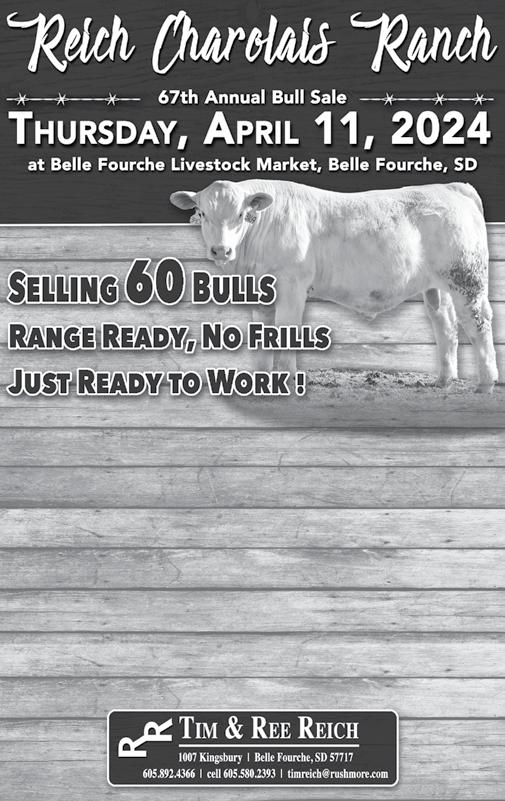
March 15-31
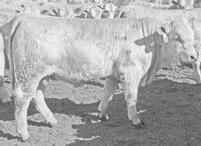
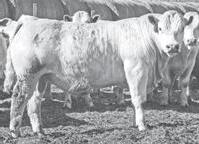
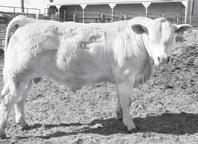
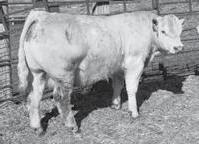
Dooley Auction Vehicles, Fusion Equipment, Pipe and Fittings Online Auction, 406-696-0412, dooleyauction.com
April 1 Snowshoe Cattle Company Annual Bull Sale, at the ranch, Arthur, Neb., 406-855-8288, 308-726-2138, snowshoecattle.com
April 2 Webo Angus Annual Turning Grass into Greenbacks Bull Sale, at the ranch, Lusk, 307-216-0090, 307-340-1182, 307-340-1499, weboangus.com
April 2 Bar 69 Angus 36th Annual Production Sale, Belle Fourche Livestock, Belle Fourche, S.D., 605-892-2875, bar69angus.com
April 2 Hinman Angus 37th Annual Bull Sale, at the ranch, Malta, Mont., 406-654-1809
April 2 Doubet Cattle Annual Bull Sale, Billings Livestock Commission, Billings, Mont., 303-638-2625, 303-681-7086, 720-302-3291
April 4 Arntzen Angus Ranch 48th Annual Production Sale, at the ranch, Hilger, Mont., 406-350-4000, 406-350-1612, 406-350-1728, arntzenangus.com
April 6 Botts Angus Ranch 11th Annual Customer-Oriented Bull Sale, at the ranch, Huntley, Mont., 541-263-0988, 541-263-0589, 308-430-2005, bottsangusranch.com
April 4-5 Midland Bull Test Final Sort Sale, Columbus, Mont., 406-322-5597, midlandbulltest.com
April 6 Big Country Genetics Bull Sale, at the ranch, Cody, 231-878-1908, bigcountrygenetics.com
April 6 Wagner Charolais 13th Annual Bull Sale, online and at the ranch, Nunn, Colo., 970-420-2336, wagner-ranch.com
April 8 Gray’s Angus Ranch Bull Sale, at the ranch, Harrison, Neb., 308-668-2525, 308-668-2520, graysangusranch.com
April 8 Colorado State University 38th Annual Yearling Commercial Angus Bull Sale, One Bar Eleven Ranch, Saratoga, 307-710-2938, 970-491-2722
April 9 Beckton’s 79th Anniversary Bull & Heifer Sale, at the ranch, Sheridan, 307674-6095, 307-674-8162, becktonredangus.com
April 9 Peak View Ranch Annual Production Sale, live online, 719-263-4321, ccilive.com, peakviewranch.com
April 9 SO Cattle Inc. Angus Bull Sale, Riverton Livestock Auction, Riverton, 307438-1218
April 10 Triple T Land and Livestock Annual Production Sale, Buffalo Livestock Marketing, Buffalo, 307-746-8509, bar-t3livestock,com
April 10 Pass Creek Angus Ranch 50th Annual Bull Production Sale, at the ranch, Wyola, Mont., 406-343-2551, 406-679-3391, passcreekangus.com
April 10 Maddux Cattle Company “Maternalizer” Bred Cow Sale, Ogallala, Livestock Auction, Ogallala, Neb., 308-350-1133, 308-414-6682, madduxcattle.com
April 11 McClun’s Lazy JM Ranch Angus & Polled Herefords Annual Production Sale, Torrington Livestock Sale Barn, Torrington, 307-575-3519, 307-5752113, 307-534-5141, mcclunranch.com
April 11 Leachman Cattle of Colorado Grass Time Private Treaty Sale, online only, 970-568-3983, leachman.com/sales
April 11 Reich Charolais Ranch 67th Annual Bull Sale, Belle Fourche Livestock Market, Belle Fourche, S.D., 605-892-4366, 605-580-2393
POSTCARD from the Past
Compiled by Dick Perue rrichardperue@gmail.com

Easter’s Symbol a Glorious Promise
Example of Nature
As a fact in nature – and certainly the resurrection of our Lord was no example of the reversal of the order of nature – Christ’s victory over the grave was a demonstration of this wondrous system exemplified by every bursting bud of spring, by the birth of every sentient being, by the constant expansion of the powers of intellect and of the love of the heart.
In nature, resurrection is continuous, and science has found no place or thing where the germ of life is not. In fact, although we may know a little about change, we know nothing whatsoever about death – the thing we fear most.
For by death we mean absence of consciousness. Yet, while we remain conscious, such a condition is unthinkable or at least impossible to realize. In fact, if one should actually be conscious of death, it would not be death, for one would be conscious of unconsciousness – a proposition contradictory on the face of it.
The very conception of a so-called “state of death” is but an indication of the limitless shores which it is possible for human consciousness to traverse.
In springtime, the lily bulb in the Earth begins to expand as if with the fever to live – this is hope. Later, a watery, white shoot climbs spirally upward toward the light – this is faith. Then, a tiny green blade appears above the ground, glad in its newborn freedom – this is knowledge.
The dews gather round the bright growing thing, the sunbeams kiss it, the rain falls upon it, the soft winds sing to it, until having assimilated something from all of the elements of its blessed new life, the plant bursts into a blossom of matchless beauty – and this is wisdom. – The
Encampment Echo, March 24, 1921 Easter lesson
From the stars of the night and the dewy grass of the spring mornings, in the notes of the birds and the music of little rills, through all of the myriad voices of nature, there comes the healing touch of patience, the consciousness that vast, eternal forces go on their majestic way quite untroubled by the ferment of human brains and the hot impulses of human hearts.
Man and woman are inspired and calmed by the spectacle of the wonderful resurrection, which every spring brings to renew their faith in ultimate good. –
The Encampment Echo, March 24, 1921
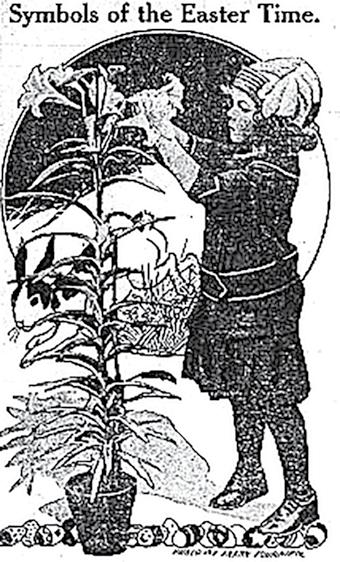
Lilies sound His praises at the Easter-tide, who from highest glory came to Earth and died.
Lo! A-dying, quite defying Satan’s mighty power, bands a-busting, our Redeemer rises in his hour. Can a pulsing, freshening lily show aught else beside happy, joyous welcome at the Eastertide.
This poem appeared in the April 1, 1915 issue of The Wyoming Times in Evanston below this illustration. Historical Reproductions by Perue
Source:
Greeley, CO
National Sheep Summary
As of March 22, 2024
Compared to last week traditional slaughter lambs 1.00-11.00 higher, others mostly 10.00-50.00 lower. Slaughter ewes mostly weak to 15.00 lower. Feeder lambs not well tested. At San Angelo, TX 8,171 head sold in a two day sale. Equity Cooperative Auction sold 275 slaughter ewes in Colorado. In direct trading slaughter ewes and feeder lambs not tested. 5,463 lamb carcasses traded with no trend due to confidentiality. All sheep sold per hundred weight (CWT) unless specified.
Slaughter Lambs: Choice and Prime 2-3
San Angelo: wooled and shorn 120-190 lbs 176.00-202.00.
Ft. Collins: wooled and shorn no report.
South Dakota: wooled and shorn 120-150 lbs 218.00-247.50; 150-175 lbs 190.00-217.00.
Billings: wooled and shorn 120-135 lbs no test. Equity Coop: no sales.
Slaughter Lambs: Choice and Prime 1-2
San Angelo: hair 40-60 lbs 272.00-298.00, few 310.00-312.00; 60-70 lbs 270.00-296.00; 70-80 lbs 262.00-288.00, few 290.00298.00; 80-90 lbs 250.00-280.00, few 282.00-286.00; 90-100 lbs 238.00-274.00, few 282.00; 100-110 lbs 230.00-276.00. wooled and shorn 69 lbs 278.00.
Ft. Collins: no report.
South Dakota: wooled and shorn 50-60 lbs 275.00-310.00; 60-70 lbs 270.00-300.00; 70-80 lbs 275.00-305.00; 80-90 lbs 285.00-310.00; 100-110 lbs 257.50-290.00. hair 40 lbs 295.00; 50-60 lbs 270.00280.00; 60-70 lbs 290.00; 70-80 lbs 255.00-275.00.
Billings: no test.
Slaughter Ewes
San Angelo: Good 3-4 (very fleshy) hair 70.00; Good 2-3 (fleshy) 84.00-99.50, hair 100.00-104.00; Utility and Good 1-3 (medium flesh) hair 116.00-135.00; Utility 1-2 (thin) 94.00106.00, hair 100.00-102.00; Cull and Utility 1-2 (very thin) hair 95.00; Cull 1 no test.
Ft. Collins: Good 3-4 (very fleshy) no report; Good 2-3 (fleshy) no report; Utility 1-2 (thin) no test; Cull 1 no test.
South Dakota: Good 3-4 (very fleshy) 71.00-105.00; Good 2-3 (fleshy) 75.00-110.00; Utility 1-2 (thin) 55.00-70.00; Cull 1 40.00-70.00.
Billings: Good 3-4 (very fleshy) no test; Good 2-3 (fleshy) no test; Utility 1-2 (thin) no test; Cull 1 no test.
Equity Coop: CO: 275: Utility and Good 1-3 89.50.
Feeder Lambs: Medium and Large 1-2
San Angelo: wooled and shorn 53 lbs 316.00. hair 29 lbs 290.00; 30-40 lbs 290.00-296.00; 40-50 lbs 276.00-316.00; 5060 lbs 280.00-290.00.
Ft. Collins: no test.
South Dakota: wooled and shorn 40-50 lbs 325.00-330.00; 5060 lbs 290.00-315.00; 60-70 lbs 238.00-292.50; 72 lbs 235.00; 80-90 lbs 215.00-222.00; 123 lbs 188.00.
Billings: no test.
Replacement Ewes: Medium and Large 1-2
San Angelo: yearling hair 130 lbs 200.00/cwt; young hair 90130 lbs 130.00-150.00/cwt.
Ft. Collins: no report.
South Dakota: yearlings 175.00-224.00/ head; bred young 167.50-250.00/head; bred middle age 185.00/head; bred aged 160.00-200.00/head.
Billings: no test. Sheep and lambs slaughter under federal inspection for the week to date totaled 40,000 compared with 40,000 last week and 44,000 last year.
Source: USDA AMS Market News, San Angelo, Texas
National Wool Review
As of March 22, 2024
Domestic wool trading had no confirmed trades reported this week. Prices reflect trades FOB warehouse in original bag or square pack, bellies out, some graded, and 76 mm or longer. No allowance made for coring, freight, or handling fees at the warehouse level to reflect net grower prices. Wools shorter than 75 mm typically discounted .10-.20 clean. Classed and skirted wools usually trade at a .10-.20 premium to original bag prices.
Compared
helping someone they never met, and they provided hay for their livestock. Quiet, a lot of hay stocks sitting around at most contacts hay yards and fields waiting for someone to come buy it. Looks like ample carry over hay as of the writing of this report.
Compared
COWBOY/RANCH HAND WANTED AT CROSS FOUR RANCH, MILES CITY, MT. Duties include: Moving and handling cattle, calving, branding, maintaining water sources, fencing, putting out salt/mineral as needed, riding pens, etc. We offer housing, groceries (beef), health insurance, life insurance, paid-time off, profit sharing bonus, competitive wages dependent on experience. Contact Fred at 406-951-3953, Julie at 406-232-4527, e-mail resume to jnowicki@midrivers.com or mail to PO Box 70, Miles City, MT 59301 3/30

FILLED


The University of Wyoming is seeking an Assistant Farm Manager at the Sheridan Research and Extension Center. The University of Wyoming is an equal opportunity/affirmative action institution. For qualifications, additional details and to apply visit https://eeik.fa.us2.oraclecloud.com/hcmUI/ CandidateExperience/en/sites/CX_1/ job/234074/?utm_medium=jobshare
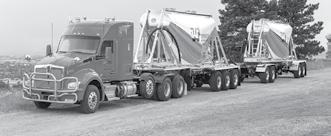

FULL- OR PART-TIME DRIVERS NEEDED FROM WORLAND TO CASPER, WY: Nighttime hours, $30/HOUR TO START. Must have CDL, pass background check and clean MVR. E-mail resumes to dingoboy6342@yahoo.com or call Matt, 801-641-4109 4/6
HELP WANTED: Five years plus cattle handling experience. All aspects of ranch operations: Irrigation, haying, feeding, cattle stewardship and horseback skills. Housing, benefits and salary. Only serious, committed candidates should apply. Eastern Oregon cow/calf operation. Send resumes to lisa.steele@ pvranch.com 4/20
CALVING HELP NEEDED: Calving, fencing, haying, general cattle work. Horses used. Call 605-347-3403 or 605499-9088 4/13

GOTTSCH LIVESTOCK FEEDERS
LLC Red Cloud, NE
Come Join the Gottsch Livestock Feeders Family! Gottsch Livestock Feeders is looking for Cowboys/Pen Riders for their feedyard in Red Cloud, NE. The main focus of the Cowboy/Pen Riders are spotting, pulling, diagnosing and taking cattle to the hospital and shipping fat cattle. This person will need to be a team player who is seeking a long-term position. You will have the opportunity to work with and learn from some of the best in the industry. We offer a benefits package that includes health insurance, dental, vision, 401(k), health savings, life insurance and paid vacation. Retention bonus offered to full-time employees. Incentives paid out at 6 months and 1 year of employment. If you are interested stop by and fill out an application or visit our website at
www.gottschcattlecompany.com
Call Brandon Furr at 402-257-7769 or 402-746-2222 for more information.
Brands
WYOMING BRAND FOR SALE: LSC, LSH. Renewal fee paid to December 2032. Irons are included, $3,500. Call 307-6749092 4/20
REGISTERED WYOMING BRAND FOR SALE: LRC, LSS, LHH, renewed to January 2029. $3,500. Call 307-8562368 4/20
WE ARE OFFERING FOR SALE THE ANCHOR
BRAND: RRC, BS, RTH.
One of Wyoming’s great one iron brands. The anchor has been a registered brand since the very early years in Wyoming, appearing in the 1909-1912 brand book. We know this brand has significant historic and monetary value and we have priced it accordingly at $15,000. If interested, you can call or message me at 307-330-4343 4/6
LAMBING HELP NEEDED. Call 307-431-2642 4/6
ASSISTANT SUPERVISOR POSITION AVAILABLE AT LARAMIE COUNTY WEED AND PEST, PINE BLUFFS, WY: This position is full time and open until filled. The position qualifications are available on our website at www. laramiecountyweedandpest. com along with the job application or by calling 307-2453213. Please mail your completed application and resume addressed to Attention: Matt Haas, district supervisor, Laramie County Weed and Pest, 801 Muddy Creek Drive, Pine Bluffs, WY 82082 and clearly marked “job application” on the envelope or by e-mail to lcwpsupervisor@gmail.com. For more information, contact Matt Haas, District Supervisor at 307-256-1979 3/30
WYOMING STATE PARKS IS HIRING ENERGETIC EMPLOYEES FOR THIS SUMMER!! The employment period will run from May until September 2024. Apply here: www.governmentjobs.com/ careers/wyoming by searching job code “ATTP99 024St. Parks & Historic Sites.” Maintenance and fee employees will be paid $10-$16/hour and law enforcement staff will be paid $18-$22/hour. Housing may be available. EEO/ ADA employer 4/6
PART-TIME DITCH RIDER
WANTED: Shell Canal Company, Greybull, WY. Call 307250-1572 3/30
HOT SPRINGS COUNTY WEED & PEST IN THERMOPOLIS, WY IS SEEKING A PROGRAM LEADER: Our ideal candidate enjoys working outdoors, has strong leadership skills and has an interest in weed science and natural resource management. This is a permanent, full-time position with benefits. EOE. Contact hscwpsupervisor@gmail.com or 307864-2278 for a complete job description and application information 3/30
SPRAY OPERATOR NEEDED FOR BETHUNE, CO AREA: Must have some experience. Salary depending on experience. Call 719-340-5480 3/30



OLD REGISTERED WYOMING BRAND FOR
SALE: LRC, LBH. Hasn’t been used for 10 years. Expires 2032. $5,000. Call 307259-2062 3/30

HISTORIC WYOMING REGISTERED BRAND FOR SALE: LRC, BS, LTH. One iron, branding iron included. Renewed to January 2033. Was originally issued in 1915 to the Jacob Delfelder estate, $5,000. Call 307-8563044 3/30
BORDER COLLIE/AUSTRALIAN SHEPHERD CROSS PUPPIES: Born March 1. Out of ranch raised, working parents. Red and white. Need homes where they can work cattle and/or sheep. Ready to go at 6 weeks. Will have had first shots and wormer. Ken & Cheri Graves, Kaycee, WY, phone 307-738-2247, cell 307-267-0724, e-mail gravesredfork@rtconnect.net 4/13
AIREDALE TERRIER OORANG
PUPPIES: AKC registered, will be large calm protective dogs. Great farm/ranch protectors from mountain lions, bears, coyotes, vermin... For more information, call 307-219-2217 or 719-2178054 (cell) 4/13
BORDER COLLIE PUPPIES
FOR SALE: Mother is a registered Juan Reyes bred cow dog, father out of our good stock dog. Puppies will have a lot of bite and be good stock dogs. Two females and 3 males. Three black and white and 2 blue. Call 435-881-7049 4/6
BORDER COLLIE PUPPIES FOR SALE: Great bloodlines, out of excellent working parents. Born Feb. 1, $500. Call 307-6453130 3/30
WANTED: PRAIRIE DOGS AND YOTES. Mature (60+), responsible, experienced Iowa hunter seeking ranchers/farmers with excess prairie dogs and/or coyotes. Precision shooting, not lead flinging. Call or text Scott at 319-431-2491 4/20
LOOKING FOR TOP QUALITY
CATTLE? I’m a North Dakota order buyer licensed and bonded. I can help you find the perfect cattle you are looking for. I buy in North Dakota and South Dakota barns. I can help you purchase feeder cattle, weighup cows, pairs and breds, replacement heifers and any other needs. I can also find country deals. Low commission rates. Feel free to call Cody Fettig at 701-391-9132 for all you cattle needs!! 4/6
WANT TO BUY LONGHORN/ CORRIENTE COWS OR HEIFERS: Bred or open. Crossbred would be ok. Must be bangs vaccinated. Call 307921-3593 3/30
STAIRCASE CHAROLAIS AND RED ANGUS ONLINE
HUGE BIRD AND ANIMAL AUCTION SUN., APRIL 14:
Selling horses, ponies, miniature cattle, goats, llamas, alpacas and birds of all types. Sale starts 9 a.m. Dawson County Fairgrounds, 1000 Plum Creek Pkwy., Lexington, NE. To consign or for more information, call 308-222-0335 or 308-233-1799 4/6
PROGRAMS designed for the farmer/rancher and not the banker. Please call Steve, 303-773-3545 or check out our website, www.agrionefinancial.com. I will come to you and get the job done!! 4/20
Brands
337-8685 4/13
BULL SALE: 50+ purebred yearling Charolais and Red Angus bulls SELLING APRIL 13-18 Timed auction online with www.DVAuction.com!! Our bulls are bred for balanced traits, functionality, disposition and efficiency to serve the cattle industry every step of the way, from the cow/calf producer all the way to the packer and consumer! For more information, visit www.staircasebulls.com, find us on Facebook or give us a call. Gus, 307-575-5860 or Amy, 308-631-1952 4/13
Horses
REFURBISHED HORSE-




Livestock
PASTURE WANTED: I am looking for a ranch lease or summer pasture lease for 250-500 pairs. Call Joe, 605-830-2210, jrcredangus@yahoo.com 4/20
PASTURE WANTED for 2,000 yearlings and 500 pairs. Can split into smaller bunches. Call 701-523-1235 4/13

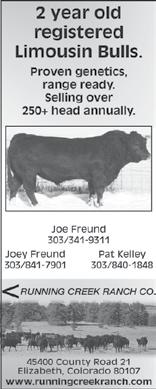
DRAWN BUGGIES: Early 1900s doctor’s buggy, $2,500. 1863 Canadian runabout, $2,000. A more modern surrey, $3,500. Two-wheel cart, $500. All OBO. ALSO have harness. All in excellent condition. Call 307-241-0396, Glendo, WY 4/6
Ranch Lease Wanted REGISTERED 2-YEAR-OLD
SIMANGUS
SEVEN EXPERIENCED BLACK
BULLS FOR SALE:
SOLD
Registered bulls ran on Union Pass last year with 90% breed up on cows and heifers. 70% bred in first cycle. Trich, fertility tested and ready to go! Three 4-year-olds, one 3-year-old, three 2-year-olds. Call or text 307-431-5423 4/6
YEARLING ANGUS BULLS:
These bulls are grown, not fattened, will get out and cover cows. Many will work on heifers. We will deliver. Call Joe Buseman, 605351-1535 5/4
YEARLING ANGUS BULLS:
Very low birthweights, $3,000/ each. Call 307-241-0396, Glendo, WY 4/6
RED ANGUS 2-YEAR OLD FORAGE BULLS FOR SALE:
Bulls for heifers and cows. Smaller framed, efficient, easy fleshing, good dispositions. Not fat, but in great shape and ready to go to work. Have been worked with dogs, on foot and horseback. Raised in rugged, rough, steep, rocky, high elevation country. Red Fork Red Angus, Ken & Cheri Graves, Kaycee, WY, phone 307-738-2247, cell 307-2670724, e-mail gravesredfork@ rtconnect.net 4/13
SALE * CHRISTENSEN RED
ANGUS * SALE: Registered, vaccinated and fertility tested bulls. We have a deep carcass, high ADG packaged with moderate to low birthweights available. Call 406-208-4315 or e-mail criters64@gmail.com 4/13
RED ANGUS HIGH-ELEVATION
YEARLING BULLS FOR SALE
IN NORTHEASTERN UTAH: Out of AI and bull-bred sires. Will be trich, semen tested and fed for free until May 1. $2,500/head. Bar Lazy TL Ranch, David, 435-828-1320, barlazytlranch@ gmail.com 6/30
SimAngus
SIMANGUS
AND FALL-BORN BULLS AVAILABLE PRIVATE TREATY: Great dispositions. Black and BWF bulls available for cows and heifers. Bulls will be semen checked and ready to go. Quantity discounts. Call Rob at Schultz Farms, 308-3903612 3/30 Hereford

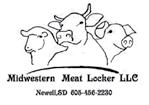
where animals thrive by connecting rich heritage to vibrant futures. Call Sage, 307-351-4875 or e-mail at saskin12@gmail. com 5/11
Horses
BEST OF THE BIG HORNS HORSE SALE, APRIL 13, Buffalo Livestock Marketing, 44 TW Rd., Buffalo, WY. Online bidding through www.cattleusa. com, register 3 days prior to sale. Contact Ellen Allemand, 307-751-8969 or Kay Lynn Allen, 406-697-5882. Visit us on Facebook for updates 4/6
TUCKER OLD WEST TRAIL
SADDLE: 17.5” seat size, western skirt, wide tree, brown wool contoured saddle pad, bridle, bit, reins, breast strap, KING RANCH
WOODEN SADDLE STAND All as new. Cody, WY. Call 307-2728520 4/20
WEANER PIGS, HOGS, WAGYU
CATTLE: Weaner pigs available April 20, full-blood Glouc., Old Spot or Mangalitsa/Old Spot crosses, $75/each. Finished hogs, pastured raised Mangalitsa /Old Spot, $300/each.1/2 blood Wagyu/Angus, $3/lb. live weight for grain finished, $2.75/lb. live weight grass finished. ALSO, full-blood Wagyu yearling bull calves available. Call 307-217-3860. To view photos, go to www.wylr.net in the classifieds 4/20
2023 OAT HAY, large rounds, net wrapped. Scale on site. Near Rapid City, S.D. Call 605-786-3272 (cell) or 605787-5373 (landline) 4/20
NORTHWEST WYOMING
CERTIFIED SEED GROWER has grass seed combine hay for sale, 3x4x8 bales. $65/ton. Call Mike Forman at 307202-0494 4/20
100 TONS ALFALFA HAY: Big round 1,400 lb. bales, $165/ ton. 100 TONS OATS/25%
BEARDLESS TRITICALE MIX, big round 1,400 lb. bales, $150/ ton. Call 308-778-6104 4/20
BARLEY STRAW: Certified weed-free small squares, $4/ bale. ALSO, 5x6 round bales, $125/ton. GRAIN/OATS, $20/ cwt. Greybull, WY area. Call 307-762-3878 or 307-8994714, leave message 4/20
600+ TONS OF GRASS HAY FOR SALE. ALSO HAVE grass/alfalfa mix and alfalfa hay, cow and barn stored. WHEAT HAY, OAT HAY AND STRAW. Small squares, 3x3s, 3x4s and round bales. Delivery available!! Large quantities still available. Call today for best price, 307-630-3046 4/20
GRASS HAY FOR SALE: 1,200 lb. 3x4x8 bales. Cow hay $120/ton. Horse hay $150/ton. Certified hay $165/ ton. Call Kelly, 307-780-7027 4/20


FOR SALE: 3/4 RED SIMANGUS BULL
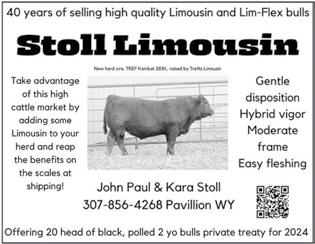
Pasture
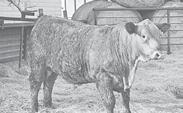
Sire: Pace • DOB: 3/12/23
BW WW 1/5
88 904
GRASS, GRASS, GRASS!! Pasture for 500 pairs. May 1-Nov. 1., south-central Wyoming, north of Rawlins, WY. Call for more information, 970-5967046 4/6
WANTED: Sugar Bars and nonSugar Bars-bred saddle horses for the 22nd ANNUAL SUGAR BARS LEGACY SALE SUNDAY, SEPT. 22. Held in Sheridan, WY. Please contact Jim, 406-8120084 or e-mail deerrunranch@ gmail.com for consignment and sale information 3/30
LAMAR COMMUNITY COLLEGE LEGACY HORSE SALE!! Join the Legacy. Lamar Community College has been training high quality performance and ranch horses since the 1970s. JOIN US ON SAT., APRIL 27 IN LAMAR, CO TO SHOP HIGH QUALITY HORSES. Mark your calendars and follow our social media pages to stay up to date on the Lamar Community College Legacy Horse Sale. RHAA Open Show at 8 a.m., previews at 1 p.m., sale at 4 p.m. 2401 S Main Street, Lamar, CO 81052. Call Ryan Bray, 719-336-6663 or Savanna Mauch, 719-3361624 4/20
ORIGINAL DOCTOR’S BUGGY FOR SALE: Dark green body, red interior, black top. Top folds back to make into a convertible. Oak wheels with rubber on them. A1 condition. Was made by W.A. Heiss Coach Company in Mifflinburg, PA, company was in business from 1884-1920. Single horse shaft, always stored inside. Worland, WY. Call 307-347-2095. To view photos, go to www.wylr.net in the classifieds 4/6
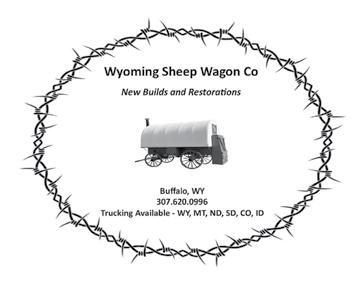
Hay & Feed
CERTIFIED BARLEY STRAW: Small bales, average 65 lbs., $5/bale. Farson, WY. Call 307350-5211 3/30
Hay
ALFALFA HAY FOR SALE
1st and 2nd Cutting
Tarped 3x4 Bales
Also Clean Wheat Straw Bozeman, MT (406) 600-4146
QUALITY GRASS/ALFALFA
MIX IN SUBLETTE COUNTY, WY AREA: Tested, tarped, 3x4 approximately 1,250 lb. square bales, $185/ton. Call Brenda for more information, 970596-4151 4/13
ALFALFA HAY FOR SALE: First-cutting big round bales, cow hay, had some rain. ALSO, first-cutting small squares in bundles of 21 bales, no rain. Riverton, WY. Call 307-8503020 4/13
800 TONS NICE, green grass/ alfalfa mix (80/20); 600 TONS MIX with rain and/or weeds (cow/grinding hay); 300 TONS GRASS HAY, green; 1,000 TONS TRITICALE HAY, mostly green, some with rain; SEVERAL LOADS MILLET HAY, nice!! All types, mostly round bales, some 3x4/4x4. Delivery available. Please call 307-630-3768. Marketed by the Cheyenne, WY area producer 4/13
GOOD QUALITY OAT HAY: 3x4 bales. Barn stored $120/ ton. Outside $110/ton. Tests available, Lusk, WY. Call Paul Hicks, 970-203-5019 4/13
ALFALFA HAY FOR SALE: 3x3 bales, 55 tons second crop. No weather damage, under tarp. $175/ton. Pavillion, WY. Ranch phone, 307-856-1226, if no answer, leave a message 4/13
2023 FIRST CUTTING ALFAL-
FA: Large net-wrapped round bales average 1,600 lbs. No rain between cutting, baling and stacking. Crude protein 20.4 and RFV 169. Located in Cody, WY. $155/ton. Can load. For more information, call 307-2502329 4/13
ROUND BALES: QUALITY
GRASS HAY FOR SALE, bales weigh approximately 1,300 lbs. each, Laramie, WY. Call 307760-8429 4/6
VALLEY VIDEO HAY MARKETS, LLC: Ranch hay consignments available now $130$160, rounds and squares alfalfa. Lusk and Torrington, WY. Scottsbluff and Lyman, NE. Go to www.valleyvideohay.com or call Barry McRea, 308-2355386 3/30
CERTIFIED WEED-FREE
PURE ALFALFA HAY: Small squares, all covered. First, second and third cutting available. Will load trucks and any open trailer. OATS: Combine run. Will auger into truck, trailer or large totes/ag bags. STRAW: Small squares available. Located between Powell and Cody, WY. Call or text Knopp Farms at 307-254-0554 4/27
ROUND BALED GRASS HAY FOR SALE: Cody, WY area, 1,000 lb. net-wrapped bales, $60/bale. Call, don’t text, Anthony at 307-254-2645 3/30
300 TONS SUDANGRASS FOR SALE, NOT SORGUM SUDAN. Light rain. Most stored under shed. 3x4s, 1,100 lb. average. Great ration mixer. Extend your good hay. Riverton, WY area. Delivery available. Call 307-709-6290 3/30
2023 ALFALFA AND ALFALFA/GRASS MIX HAY, 3x3 bales barn stored. ALSO, SOME FEEDER HAY and BARLEY STRAW available. Call 307350-0350, Farson, WY 3/30
2023 OAT HAY FOR SALE: Good and green with lots of oats, 1,500 lb. round bales, plastic twine. Tested low in nitrates. $110/ton, 45 miles west of Fort Pierre, S.D. Call 605224-6100, if no answer leave message 3/30
285 PLUS TONS OF 2023
GRASS HAY: 3x4, $175/ton, Encampment, WY. Call 307321-1444 TFN
CERTIFIED BARLEY STRAW FOR SALE, 3x4 bales. Cody, WY. Call 307-899-1952 TFN
Warner Ranch Seed
Serving Fremont County, Wyoming and the surrounding areas.
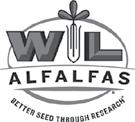
HarvXtra® alfalfa with Roundup Ready® technology, Roundup Ready® alfalfa and conventional varieties available!
Plant the best!
Buffalo Brand Seed for annual forages, cover crops, pasture grasses, small grains and custom mixes. Call Today!

Bryan Warner • 307-850-7668 (cell)
out produces hybrid for silage and grazing quality grain, $67/bushel +S/H. Call 217-857-3377 or cell/text 217343-4962, visit website www. borriesopenpollinatedseedcorn.com 4/20
GRASS SEED FOR SALE: Manifest wheatgrass and Cache Meadow brome, good germination, $3/lb. Call Big Horn Seed Company, 307-202-0704 or 307-645-3322 3/30
Vehicles & Trailers
1997 FREIGHTLINER FLD120 FOR SALE: New paint, 8 new driver tires. Clean interior. Set up with ball to pull trailer. Fresh oil change. Good front end tires. Really good truck, like new!! $34,500. Call Jerry Haensel, 605-321-9237, Montrose, S.D. 4/20
WANTED!!! 1932, 1933 or 1934 Ford car project, unrestored or restored. Call 605-290-3208 3/30
ATVs
2006 POLARIS 500: 4,000 miles, excellent condition, always garaged, extra set of tires and wheels, $3,200. 2016 KAWASAKI TEREX side-by-side, excellent condition, always garaged, $7,500. ALSO 3 PT. ROUND BALE FEEDER, like new, make offer. Call 307-3883300 4/20
ELSTON 3 PT. GOPHER GETTER, rebuilt hitch, stored inside, $950. Call 307-7156184 4/6
GRAHAM HOEME CHISEL
PLOW: 12’, 12 double spring shanks with cylinder and hoses, $3,000. 24-FOOT JOHN DEERE
1100 CULTIVATOR 3 pt. hookup, $3,750. INTERNATIONAL 5100 12’ single disc drill with small seed box, $4,000. Call 307-6749092 4/20
FOR SALE: 7140 International Magnum tractor. D4 Caterpillar hydraulic dozer with manual angle. 9600 John Deere combine with 930 30’ grain header and a 893 8 row 30” corn header. 20’ Krause offset disc (new blades in front). ALSO, 8 feeder pigs. Contact Greg Keller at 406-6791136 4/13
FOR SALE: John Deere 2155 diesel tractor, wide front, fenders, 3 pt., nice acreage tractor. Notch 24’ portable ground hay feeder. 12’x24’ heavy duty bale hauler. Phoenix H14 42’ rotary harrow. H&S 7+4 17’ and 16’ chuckwagons with bunk feeding extensions and tandem 14 ton running gear. Meyer 18’ chuckwagon with bunk feeding extensions and 14 ton gear, very nice. Two John Deere 716A chuckwagons with John Deere running gear and bunk feeding extensions, been shedded, nice condition. Big Valley cattle working chute with automatic headgate. Lorenz 16’x29’ stack mover. 12’ box scraper. All in very nice condition!! Call 605999-5482 4/6
Rupp Hydraulic Calf Tables

• Handles Calves up to 300 lbs.
• Handles Calves up to 300 lbs.
• Operates off tractor, bale bed or remote hydraulic unit.
• Operates off tractor, bale bed or remote hydraulic unit.
Call Darin Coyle, Big Horn Livestock Services, Inc. 307-851-1634 • www.bighornlivestock.com
Call Kevin McClurg, Big Horn Livestock Services 307-751-1828 • bighornlivestock.com
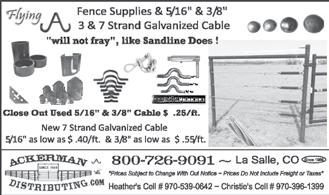

LODGEPOLE PRODUCTS, 307-742-6992, SERVING AGRIBUSINESSES SINCE 1975!! Treated posts, corral poles, buckand-rail, western rail, fence stays, rough-sawn lumber, bedding. SEE US at www.lodgepoleproducts.com and click our “Picking A Fence Post” tab to see why folks choose our posts!! TFN
USED IRRIGATION PIVOTS FOR SALE FROM LEADING
BRANDS: Valley, Zimmatic, Reinke and T-L. Visit website www. zimmag.com Current available used inventory
2021 Zimmatic 8500
1,295+ ● 2013 Valley 7000 7 tow-
er 1,336+ ● 2014 T-L Corner Arm only. Call 402-910-3236 4/13
NORTHEAST OREGON, THE DLX RANCH: Located near Baker City, OR the DLX is noted as one of the most productive and finest ranches around. It is well balanced and contains 17,000 deed acres with 4,000 acres of irrigated meadows and cropland. Native and improved rangeland provides good spring and summer pasture. The ranch is well improved with nice homes, excellent livestock working facilities and is noted for its production and ease of operation and management. Abundant water and over 6 miles of the Powder River running through the ranch provide for not only production but unbelievable waterfowl and upland game bird habitat. The ranch also provides good populations of elk and mule deer. Situated in the heart of the Baker Valley, the ranch enjoys very scenic mountain views and is very private yet only a short drive to Baker City, OR. Currently operated as a commercial cow/calf operation with a permitted feedlot. The ranch would also make an ideal yearling or combination operation. It is rare to find this quality of a ranch and particularly a property that is a going concern. This is a first-time offering and we look forward to hearing from you. $32,500,000. Livestock and rolling stock available by separate treaty. Please give us a call for further information, Greg Sackos, 541-523-4434 (office) or 208-598-0267 (cell), Intermountain Realty, www.intermountainland.com 4/20
OLD FARM WITH 3 BEDROOM, 1 BATH HOUSE. Nice out buildings, hundreds of trees, well, natural gas. House needs work. Eight to 14 acres, Powell, WY. $349,000. Call 307-219-2217 or 719-217-8054 4/13
HOME FOR SALE BY OWNER!!
97 SW. Ash St., Lewistown, MT, 3,000 sq. ft. 3 bedroom, 3 bath with basement. Nice size man cave, 46’x48’ shop with loft and bathroom, 12’ doors on shop. Creek in backyard with a greenhouse. Approximately 2 acres front and back of house. Asking $897,250. For more information, call 406-3500919. To view photos, go to www. wylr.net in the classifieds 3/30
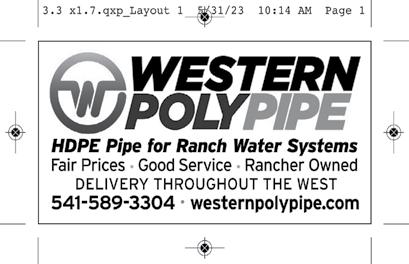

Trailer Services/ Repairs
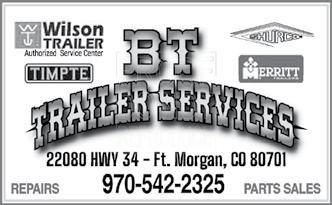
Equipment
2020 JOHN DEERE 3046R
TRACTOR: 4x4, low hours. Quick Attach 3 pt. hitch. Rear blade. Post hole digger 8” and 12”, 3 pt. Rototiller, 5’ Quick Attach loader, 3 pt. brush hog, dozer blade and bucket forks. $49,500. Call 307-3311151 or 307-214-0814. To view photos, go to www.wylr.net in the classifieds 3/30
Hay Equipment
NEW HOLLAND 560 ROLL BELT BALER, bale count 178 bales, in shop every night, $55,000. 2001 MACDON 9250 SWATHER with 922 auger head, 1,771 hours on tractor, 1,384 hours on head, $45,000. Area fields are being subdivided. Call 307-6749092 4/20
OILFIELD PIPE: PRICE REDUCED!! RPJ Enterprises, Inc. 2 3/8” and 2 7/8” is available. Used for fencing, corrals, cattle guards, etc. 2 3/8” and 2 7/8” are on average 31.5’ long per joint. Pierce, CO. Call for details, 970-324-4580 7/27
PIPE FOR SALE!! 2 7/8”, 3 1/2” tubing, 4” drill pipe, 4 1/2” casing, 5” casing, 7” casing. Rods 3/4”, 7/8” and 1” located in Montana, can ship anywhere. Call Mike, 602-758-4447. To view photos, go to www.wylr.net in the classifieds 4/20
OREGON RANCH, Baker City, Baker County, OR. The Alder Creek pasture contains over 2,000 acres of native spring, summer and fall pasture. The rangeland is situated just east of Baker City, OR. The property is in good condition and has good perimeter fencing. The range is gently south facing slope with a variety of native grass. FIRST-TIME OFFERING at just over $500 per acre for deeded and contiguous ownership, $1,095,000. Please give us a call for further information, Greg Sackos, 541-523-4434 (office) or 208-598-0267 (cell), Intermountain Realty, www.intermountainland.com 4/20
Irrigation Systems
The choice is simple.
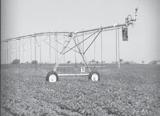
No wire to steal! Easier On You.
Copper wire is being stolen from electrically powered pivot systems world-wide. Many growers have resorted to 24-hour guards, razor wire, floodlights and daily disassembly to protect themselves. T-L’s hydraulically powered pivot systems can be designed with little or no wire to steal. Stop theft and discover T-L’s reliability, simplicity and low maintenance cost. T-L irrigation systems are easier on you - for life.
Big Horn Truck and Equipment Manderson, WY rairdenjlw@tritel.net • 800-770-6280
WILKES RANCH is a great opportunity to own a thriving crop and cattle ranch in Goshen County, WY. Includes a nice home, livestock barn and center pivot. This property is well-equipped to support optimal crop and hay production, as well as efficient cattle rotation. Located near Hawk Springs, WY. $800,000. Pictures and video at www.buyaranch. com. Call Casey Essert, Land Broker, 307-532-1750 3/30
RECENT SALES FREMONT COUNTY, WY
Property for Sale
66.856 ACRES, JUST NORTHWEST OF RED LODGE, MT BORDERING
Hunting & Fishing
Hunting & Fishing
SAND BUTTE RANCH: 1,428 deeded acres, 522 irrigated. Five pivots plus some sideroll and gated pipe. Two sets of improvements. $4,500,000
MOUNTAIN VIEW RANCH: 200 deeded acres, 170 irrigated. Live water. Gated pipe. Newly remodeled farm house. $1,300,000
BUCKNELL RANCHETTE: 67 acres, 40 irrigated. Newer stick built home and large shop. $695,000
133 SHETLAND RD: 20 acres, 14 irrigated. 2,700 sq. ft. split level home built in 2000. Detached garage and open front shed. $495,000
1228 HWY 26: Three acres, newly remodeled home. $295,000
SOLD SOLD SOLD SOLD SOLD
People from around the country are still considering Fremont County, especially in the Midvale Irrigation District, a bargain. If you have thought about selling, the market is hot right now.
RANGE REALTY, LLC
Fred Nelson, Broker/Owner 307.840.0593
255 Shetland Road • Riverton, WY 82501 email: kinnear@wyoming.com www.wyomingrangerealty.com
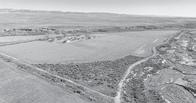

307-851-8791
• 83.5 Acre Farm
• 64.3 Irrigated
• Alfalfa Crop
• Live Water
• Outbuildings
• Recently remodeled 5 bedroom 2.5 bath home

UW continued from page 1
section of land.
In her position working for a midstream company, Burch noted one of the biggest challenges she has faced is aligning a timeline which works for both parties.
“A company or operator may have a stringent schedule, while the surface owner they are trying to cut a deal with may not necessarily be on board with this timeline,” she said. “Timelines shift and change. It just comes down to knowing what is important to the landowners and ranchers and keeping an open line of communication between both parties.”
Barlow shared, as the owner and operator of his family ranch in Gillette, the biggest challenge he has experienced is finding the time and necessary resources to understand what kind of changes and consequences he might run into regarding energy development on his operation.
Terry agreed, adding, “A rancher’s ultimate concern is their private property rights. Former President George Washington is quoted saying, ‘Private property rights and freedom
THE GOLF COURSE: This property is presently agriculturally zoned, current use is hay and pasture and it is fenced and cross fenced. Enjoy views of several mountain ranges and lots of water, including Spring Creek frontage, mature trees and lush grass. Could be zoned commercially, allowing for development of a number of homesites and/or other commercial ventures. This property is simply loaded with possibilities. Access is off Willow Creek Road. DNRC Right Nos. 43D 216331-00 and 43D 200020-00, Pryde Ditch and West Fork of Rock Creek. $2,300,000. Property to be shown by appointment only and listing agent shall accompany all showings. Sellers
Have Property to Sell?
Advertise Here!
are inseparable. You can’t have one without the other.’
In production agriculture, these property rights are something we want to last for generations, not just for a few years.”
Benefits
Although some kind of challenge always exists among collaborators, many of the panelists concurred the positives outweigh the negatives.
“I can think of way more positive things about oil and gas activity in Wyoming for ranchers than I can negative,” remarked Burch.
Burch and Schramm noted oil and gas activity provides ranchers with well-maintained roads which allow for year-round access to land that may otherwise not be available for use during certain times of the year.
Terry and Frank both touched on the fact royalties and other payments made to landowners who have instituted some kind of mineral development on their operation help keep them financially sustainable.
Eden commented, “From the coal mine per-
Miscellaneous
FOR SALE: OXEN YOKE, very old, antique, wooden, hand carved, 5’ length, from Spain. CATTLE YOKE, old, antique, wooden, hand carved, 40” length, from Spain. Cody, WY. Call 307272-8520 4/20
spective, I think there is a really unique interface which allows for mutual development and a great reward on the back end when we have reclaimed the land and turned it back over to the rancher. It creates a wonderful opportunity.”
Additionally, Barlow mentioned these benefits reach further than those immediately involved.
“I will speak a little in my role in the state government. Think about the schools we have in this state,” he said. “The coal bid bonus money from Campbell County has built schools all over the state of Wyoming for the past 20 years.”
“The benefits of energy are not just for individual families, but the broader community in the state of Wyoming,” he added.
Opportunities
To wrap up the discussion, the panel mulled over their thoughts on opportunities in the carbon market and the future of energy exploration and ranch management collaboration.
While many of the panelists agreed there is an opportunity for ranchers in the carbon market, Terry shared she believes it is simply a political trend that
Voelker’s Body Shop; Upton 7:20-7:40 a.m., Joe’s Grocery (drive thru, call); Moorcroft 8-8:20 a.m., The Coffee Cup (drive thru, call); Sundance 8:459:30 a.m., Rapid Stop; Beulah 10-10:20 a.m., Truck Stop (drive thru, call); Spearfish, S.D. 10:30-11 a.m., Butcher Shop; Belle Fourche, S.D. 11:30 a.m.-12 p.m., Runnings (NE parking lot); Aladdin 12:20-12:50 p.m., General Store (drive thru, call); Hulett 1-1:30 p.m., Tower Valley Ag Supply; Alzada, MT 2:15-2:30 p.m., B&J Convenience (drive thru, call); Gillette 7-7:30 p.m., Rocky Mountain Sports and Howard Johnson Motel room 143 7:45-8:15 p.m. APRIL 12: Gillette 5:45-6 a.m., Rocky Mountain Sports (drive thru, call); Wright 6:30-7 a.m., Big D (drive thru); Midwest 7:508:10 a.m., Sinclair Truck Stop (drive thru, call); Kaycee 8:35-9 a.m., Sinclair Truck Stop; Sheridan 10:30-11 a.m., Sportsman’s Warehouse; Buffalo 11:45 a.m.-12:15 p.m., Good 2 Go; Ten Sleep 1:502:20 p.m., Pony Express; Hyattville 3-3:20 p.m., Paint Rock Processing (drive thru, call); Manderson 3:50-4:10 p.m., Hiway Bar (drive thru, call); Basin 4:10-4:35 p.m., Overland Express Mart (drive, thru); Greybull 4:50-5:10 p.m., Overland Express Mart (drive thru, call); Lovell 5:506:20 p.m., Good 2 Go (drive thru); Powell 6:50-7:10 p.m., Murdoch’s (drive thru); Cody 7:40-8 p.m., Nature’s Design Taxidermy. For more information, call Greg, 308-7500700 or visit www.petskafur. net 4/6
will fade out in the next decade.
“I would say we just need to stay informed and keep an eye on political whims,” she said. “I would say we should just grow more grass.”
On the contrary, Barlow explained northeast Wyoming is already seeing some opportunity in the carbon market with the CO2 line that runs from the southwest corner of the state to Montana.
“This line is mostly used for enhanced oil recovery, which is certainly a carbon market to improve existing wells,” he said. “There are also deals being signed in Campbell County right now for future sequestration projects.”
Burch said she believes there is a an opportunity for ranchers in the carbon market and that it is a good way to diversify an operation’s income.
Schramm pointed out there is still a lot to learn regarding carbon.
“The thing many of us need to learn about is something called a class six well,” he explained. “We have to have a class six well to go deep into a formation to pump carbon so it won’t leak.”
ANTLER MARKET STEADY TO STRONG!!! APRIL 13-15 PETSKA FUR WILL BE BUYING ALL GRADES OF ANTLER AND LATE SEASON FUR IN THE FOLLOWING TOWNS AND LOCATIONS: APRIL 13: Meeteetse 6:30-6:45 a.m., Elk Horn Bar; Worland 7:50-8:20 a.m., Coop One Stop; Thermopolis 9-9:20 a.m., Renegade Guns; Shoshoni 10:10-10:30 a.m., public restrooms/bus stop (drive thru, call); Riverton 11:15-11:45 a.m., Vic’s Body Shop (behind the Dollar Tree); Hudson 12:15-12:30 p.m., Wyoming Custom Meats (drive thru, call/text); Lander 12:50-1:30 p.m., Zanders; Jeffrey City 2:302:45 p.m., Split Rock Cafe (drive thru); Muddy Gap 3-3:10 p.m., (drive thru, call/text); Alcova 3:504 p.m., Sloanes General Store (drive thru, call/text); Casper 4:30-5:15 p.m., Wagner Outdoor Sports; Glenrock 5:45-6 p.m., east exit on I-25 (drive thru, call/text); Douglas 6:30-6:40 p.m., Douglas Feed. APRIL 14: Douglas 6:306:45 a.m., Douglas Feed; Orin Junction 7:10-7:30 a.m., Truck Stop (drive thru, call); Lost Springs 7:40-8 a.m., truck pull off 1 mile east (drive thru, call); Manville 8:10-8:30 a.m., Truck Stop (drive thru, call); Lusk 8:40 a.m.-9:10 a.m., Decker’s Grocery; Hartville 9:50-10 a.m., Miner’s & Stockman’s Restaurant (drive thru, call); Guernsey 10:15-10:45 a.m., Crazy Tony’s; Wheatland 11:15-11:45 a.m., Wheatland Travel Center; Chugwater 12:15-12:30 p.m., Stampede Saloon (drive thru); Cheyenne 1:15-1:45 p.m., Tractor Supply; Archer 2:10-2:30 p.m., Home on the Ranch Processing (drive thru, call); Carpenter 2:30-3 p.m., Antelope Truck Stop (drive thru, call); Pine Bluffs 3:15-3:30 p.m., Sinclair (drive thru, call). APRIL 15: LaGrange 7-7:20 a.m., Bear Mtn. Stage Stop (drive thru, call Greg); Hawk Springs 7:307:45 a.m., Longbranch Saloon (drive thru, call Greg); Yoder 7:508 a.m., Post Office/Community Building (drive thru, call Greg); Lingle 8:20-8:40 a.m., Ty’s Pit Stop; Torrington 9:10-9:30 a.m., Gary’s Gunshop (drive thru). For more information, call Greg, 308-7500700 or visit www.petskafur.net 4/6
GOING, GOING, GONE. THAT'S WHAT YOU'LL SAY WITH ROUNDUP CLASSIFIEDS
He further suggested individuals seek legal advice when getting involved with carbon sequestration in order to avoid trouble down the road.
“We are pumping hazardous waste, and the last thing we need is a leak because as an owner of the pore space we might have to defend ourselves and/ or our ranch,” he stated. “We need some confirmation from the Environmental Protection Agency we won’t be held reliable.”
Eden agreed, noting to his knowledge, only one class six well is currently permitted in the state.
“Without this key component of infrastructure, I think underground carbon sequestration is going to struggle,” he said.
When it comes to the future of collaboration between energy exploration and ranch management, all parties agreed the state of Wyoming presents a wonderful venue for beneficial partnerships between both industries.
Hannah Bugas is the managing editor of the Wyoming Livestock Roundup. Send comments on this article to roundup@ wylr.net.
ANTLER MARKET STEADY TO STRONG!!! MAY 3-5 PETSKA FUR WILL BE BUYING ALL GRADES OF ANTLER AND LATE SEASON FUR IN THE FOLLOWING TOWNS AND LOCATIONS: MAY 3: Ft. Bridger 1:30-1:50 p.m., Cash Store; Evanston 2:30-3:15 p.m., Prairie Inn; Woodruff, UT 3:50-4 pm., Country Store (drive thru); Randolph, UT 4:15-4:30, Crawford’s Trough; Kemmerer 5:10-5:40 p.m., Ham’s Fork Station; Cokeville 6:30-6:50 p.m., Flying J Truck (drive thru, call); Montpelier, ID 7:30-8 p.m., Gunderson’s Ace Hardware. MAY 4: Afton 6:30-7 a.m., Gardner’s Country Village; Thayne 7:10-7:20 a.m., Farmer’s Feed (drive thru, call); Etna 7:20-7:30 a.m., Etna Trading Post (drive thru, call); Alpine 7:50-8:20 a.m. Tack & Treasure Gun Shop; Hoback Jct. 8:50-9:10 a.m., Hoback Market/Exxon; Bondurant 9:30-9:45 a.m., Elk Horn Bar (drive thru, call); Daniel 10:10-10:30 a.m., The Den; Pinedale 10:50-11:10 a.m., Gannett Sports; Big Piney 12-12:15 p.m., Public RR/Visitor Info. lot; La Barge 12:45-1 p.m., All American Fuel (drive thru, call); Green River 2:30-2:45 p.m., Hitching Post (drive thru, call); Rock Springs 3:20-3:50 p.m., WY Wool Warehouse; Wamsutter 5-5:15 p.m., Conoco (drive thru, call); Rawlins 6-6:20 p.m., Tractor Supply; Encampment 7:40-8 p.m., Trading Post (drive thru, call). MAY 5: Saratoga 6:30-7:40 a.m. Saratoga Feed & Grain; Elk Mountain 7:50-8 a.m., Conoco on I-80 (drive thru, call); Hanna 8:15-8:30 a.m., Hanna Market (drive thru, call); Medicine Bow 8:45-9 a.m., JB’s (drive thru, call); Rock River 9:20-9:30 a.m., Rancher’s Supply (drive thru, call); Laramie 10:40-11:40 a.m., West Laramie Fly Shop. For more information, call Greg, 308750-0700 or visit www.petskafur.net 4/27
TANK COATINGS ROOF COATINGS
Available for METAL, composition shingles or tar roofs. Long lasting and easy to apply. We also manufacture tank coatings for concrete, rock, steel, galvanized or mobile tanks.

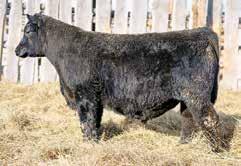
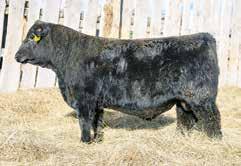
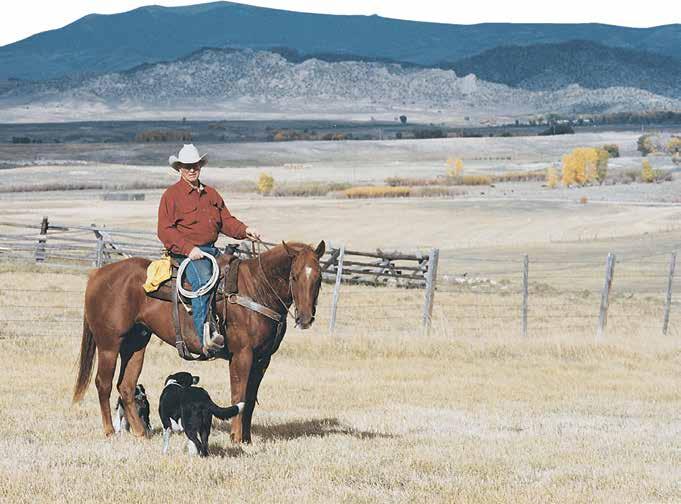
Reported By: Curt Cox, WYLR Field Editor March 21-22, 2024
Billings, Mont.
Auctioneers: Roger Jacobs, Joe Goggins, Ty Thompson, Bill Cook and Greg Goggins
449 Yearling Angus Bulls Avg. $8,303
5,273 Commercial Yearling Heifers Avg. $2,176
Top Sellers
Lot 113 – Vermilion Leo L045 – Price: $50,000 DOB: 2/2/23 Sire: Vermilion Leo Dam’s Sire: HF Alcatraz 60F
EPDs: BW: +0.1, WW: +79, YW: +133 and Milk: +34 Buyer: Clear Creek Angus, Chinook, Mont.
Lot 48 – Vermilion Three Rivers L171 – Price: $32,000
DOB: 2/4/23 Sire: Ellingson Three Rivers 0065 Dam’s Sire: KG Premium Asset 7161 EPDs: BW: +2.5, WW: +91, YW: +150 and Milk: +24 Buyer: Hinman Angus, Malta, Mont.
Lot 216 – Vermilion Fair N Square L355 – Price: $25,000
DOB: 2/17/23 Sire: Myers Fair-N-Square M39 Dam’s Sire: Casino Bomber N33 EPDs: BW: +1.4, WW: +77, YW: +144 and Milk: +29 Buyer: Schurrtop Angus, Farnam, Neb.
Lot 100 – Vermilion Badlands L057 – Price: $23,000
DOB: 1/31/23 Sire: Ellingson Badlands 0285 Dam’s Sire: Vermilion Spur D125 EPDs: BW: +3.7, WW: +83, YW: +142 and Milk: +20 Buyer: Bob Stoddard, Newcastle
Lot 37 – Vermilion Growth Fund L590 – Price: $19,000
DOB: 2/28/23 Sire: Deer Valley Growth Fund Dam’s Sire: Connealy Countdown EPDs: BW: +0.4, WW: +94, YW: +161 and Milk: +28 Buyer: Bob Stoddard, Newcastle
Lot 131 – Vermilion King Air L076-– Price: $17,000 DOB: 1/31/23 Sire: Connealy King Air Dam’s Sire: Casino Bomber N33 EPDs: BW: -1.5, WW: +73, YW: +131 and Milk: +23 Buyer: Bob Stoddard, Newcastle
Lot 2 – Vermilion G017 Bomber L164 – Price: $17,000
DOB: 2/8/23 Sire: Vermilion Bomber G017 Dam’s Sire: Connealy Countdown EPDs: BW: +2.4, WW: +105, YW: +180 and Milk: +33 Buyer: Zentner Angus, Bridger, Mont.



Crissman Ranch- 110 Blk Ang Hfrs 600#. 3 rounds of vacc. Bangs vacc. 100% Blk Angus sired. One brand, high elevation & green!!
Six Iron Ranch- 65 Red Ang Replacement Heifers 775-825#. Bangs Vacc. 45 Red Ang Strs 750#. Rec Pyramid 5 w/ Presponse, Vision 8 w/ Somnus, Once PMH IN & poured @ Branding & Weaning. Reputation genetics, high desert calves that are raised to perform!
Tom & Amy Reed- 35 Blk Ang Hfrs 675-725#. Comp vacc Spring & Fall. Poured w/ Clean Up 3-10. One brand. Fancy, reputation quality Heifers!
& 4 yr olds. Bred to Blk Ang bulls to calve in May. Rec shots and poured last fall. Nice high elevation cows!
Obsidian Angus- 5 Blk Ang 8-10 yr old bred cows. Proven cows out of registered herd. Calving now!
HEIFER PAIRS
Fleur de Lis Cattle Co- 50 Blk Ang 2 Yr old Heifer Pairs 1000-1100#. Calves are sired by Reyes Blk Ang bulls. Heifers rec Virashield 6 VL5, Multi-Min & Poured last fall. Calves rec Bo-Se & C&D @ birth. Tagged to match. Nice heifers w/ big stout calves @ their side!
Fisher Ranch- 30 Blk Ang 3 & 4 Yr old Pairs. Tagged to match. Nice young cows w/ good calves @ side.
Herb Finlayson- 10 Blk Ang Young Pairs. Nice Blk calves @ side!
Bitterroot Ranch- 2 Blk Ang Heifer Pairs. Nice calves, tagged to match! PAIRS
Fleur de Lis Cattle Co- 36 Blk Ang 3-6 yr old Pairs. Calves are sired by Reyes Blk Ang bulls. Cows rec Virashield 6 VL5, Multi-Min & Poured last fall. Calves rec Bo-Se & C&D @ birth. Tagged to match. Nice cows w/ big stout calves @ their side!
Bitterroot Ranch- 1 Blk Ang 4 yr old Pair. Nice calf, tagged to match!
BULLS
SO Cattle Co- 18 Blk Ang Yearling bulls. PAP Tested, Semen tested. Ready for turn out! For more information call Mark McConnell @ 307438-1218
Kaylynn Weber- 1 Yearling Hereford Polled bull 945#. Fancy, LBW, High growth genetics. Out of NJW bloodlines. Shown @ Jr Hereford show. Gentle & super growthy!
APRIL 23
BULLS
Lazy BV Cattle- 20 Yearling Bulls (Sim/Ang & Blk Ang) Sim/Ang bulls are sired by CCR Boulder, CCR Cowboy Cut & CCR Powerline Trinity. Ang bulls are sired by GR Patriarch, GB Fireball & JR Fast Forward. PAP Tested, Semen tested, out of AI Sires.
TUESDAY, APRIL 30
ALL CATTLE CLASSES W/ SHEEP & HORSES
TIME 9:00 AM W/ SHEEP & WEIGH UPS
